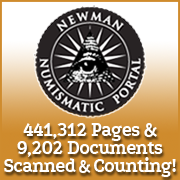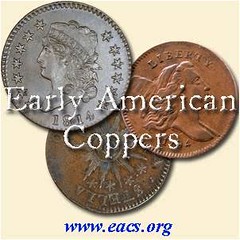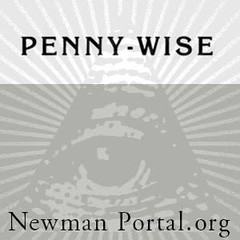
About UsThe Numismatic Bibliomania Society is a non-profit organization devoted to the study and enjoyment of numismatic literature. For more information please see our web site at coinbooks.org SubscriptionsThose wishing to become new E-Sylum subscribers (or wishing to Unsubscribe) can go to the following web page link MembershipThere is a membership application available on the web site Membership Application To join, print the application and return it with your check to the address printed on the application. Print/Digital membership is $40 to addresses in the U.S., and $60 elsewhere. A digital-only membership is available for $25. For those without web access, write to: Terry White, Treasurer AsylumFor Asylum mailing address changes and other membership questions, contact Terry at this email address: terrywhite5475@yahoo.com SubmissionsTo submit items for publication in The E-Sylum, just Reply to this message, or write to the Editor at this address: whomren@gmail.com BUY THE BOOK BEFORE THE COINSale Calendar |
- WAYNE'S WORDS: THE E-SYLUM NOVEMBER 20, 2016
- STACK'S BOWERS HOLIDAY SEASON BOOK OFFER
- FRED LAKE'S 27 YEARS IN NUMISMATIC LITERATURE
- NEWMAN PORTAL SCANS FORD AUCTION SALE CATALOGS
- NUMISMATICS INTERNATIONAL BULLETIN ONLINE
- AN AMERICAN SCHOOL OF ENGRAVING
- NOTES FROM E-SYLUM READERS: NOVEMBER 20, 2016
- DAVID LANGE'S COIN ALBUM MUSEUM
- MERCANTI'S FIRST LOOK
- VOCABULARY TERM: BURIN
- HORACE MAITLAND GRANT (1873-1960)
- MELVIN JONES: BESIDE HIMSELF
- THE HOODOO HALF DOLLAR
- SELECTIONS FROM NUMISMATIC AUCTIONS SALE 60
- DONALD YOUNG EXONUMIA IN HOLABIRD SALE
- ARCHIVES INTERNATIONAL DECEMBER 2016 SALE
- VICTORIA CROSS MEDAL FOUND IN THAMES RIVER
- THE ALLY FINANCIAL LUCKY PENNY FOUND
- SHANNA SCHMIDT NUMISMATICS INC. LAUNCHED
- WAYNE'S NUMISMATIC DIARY: NOVEMBER 20, 2016
- SILBANNACUS, THE EMPEROR THAT TIME FORGOT
- PRINCETON OPENS NEW PERMANENT COIN EXHIBIT
- ENGLISH CIVIL WAR SILVER COIN HOARD FOUND
- FRENCH JETONS FOUND IN RUSSIA
- QUEEN ANNE 'VIGO' GOLD FIVE GUINEA SOLD
- 1912 TIFFANY CARPATHIA MEDAL SOLD
- 1933 FOOTBALL ASSOCIATION CUP MEDAL
- SHERLOCK HOLMES CARD DEALER 'COIN'
- U.S. PRESIDENT CHANGE DRIVES NUMISMATICS
- A COAST GUARD CUTTER EXCHANGE NOTE
- PUBLIC PROPOSES NEW BANKNOTE DESIGNS FOR EGYPT
- MASSIVE COUNTERFEIT CURRENCY BUST IN PERU
- INDIA'S BANKNOTE WOES CONTINUE TO MOUNT
- INDIA BANKS RECIRCULATE SOILED BANKNOTES
- FEATURED WEB SITE: NUMISMATICS INTERNATIONAL
Click here to access the complete archive
To comment or submit articles, reply to whomren@gmail.com
WAYNE'S WORDS: THE E-SYLUM NOVEMBER 20, 2016
New subscribers this week include: Steven Helfer, Bill Carm, and Ivan Rakyta. Welcome aboard! We now have 2,038 subscribers. Welcome also to new advertiser Shanna Schmidt.
This week we open with a book offer from Stack's Bowers, comments on Fred Lake's numismatic literature career, and two updates on the Newman Numismatic Portal. No new books or reviews this week.
Other topics this week include David Lange's Coin Album Museum, dealer Horace M. Grant, medals of Lions Clubs International founder Melvin Jones, selections from three upcoming auction sales, my numismatic diary, the Carpathia medal, a counterfeit currency bust, and India's continuing banknote woes.
To learn more about Numismatics International, an American School of Engraving, San Francisco Mint Superintendent George B. Gillin, Mercanti's Australian Wedge-tailed Eagle, Grant's Tomb, the Hoodoo Half Dollar of Death, the Portola Festival Dollar, the earliest known set of U.S. token dies, Princeton's new coin exhibit, and the Emperor That Time Forgot, read on. Have a great week, everyone!
Wayne Homren
Editor, The E-Sylum

STACK'S BOWERS HOLIDAY SEASON BOOK OFFER
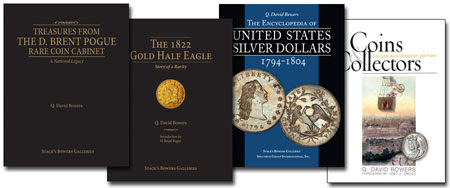
Whether as a gift for yourself or for your favorite collector, there is nothing better than great numismatic books by Q. David Bowers. Unless, of course, it is great numismatic books at a great holiday price! Stack's Bowers Galleries is pleased to offer our 2016 Holiday Reading Special – a chance for you to receive three entertaining and informative books at one great price.
In conjunction with Stack's Bowers Galleries' presentation of the D. Brent Pogue Collection, Q. David Bowers has written
Treasures from the D. Brent Pogue Rare Coin Cabinet, 208 pages, color illustrated, quality hardbound. List price: $39.95
The 1822 Gold Half Eagle: Story of Rarities, 128 pages, color illustrated, quality hardbound. List price: $39.95
For a limited time, order both of Dave's books on the D. Brent Pogue Collection and receive more than 30% off the list price. Your cost for the set will be only $54 plus $6 shipping (via media mail to U.S. addresses) for a total price of $60.
In addition, if you order before December 31, 2016, we will include one of two other "great reads" by Dave Bowers free of charge. Choose from:
Coins and Collectors, Golden Anniversary Edition (List price $29.95) OR
The Encyclopedia of United States Silver Dollars, 1794-1804. (List price $49.95).
To take advantage of this special offer call 866-811-1804 today!

FRED LAKE'S 27 YEARS IN NUMISMATIC LITERATURE
Jeff Reichenberger writes:
Best wishes to Fred Lake. My first ventures into numismatic literature auctions were through Fred's offerings. Always cordial and easy to communicate with, I enjoyed the homespun nature with which he conducted business. He will be missed.
Len Augsburger writes:
I never met Fred in person but of course “knew” him from his sale catalogs that arrived every two to three months. Fred didn't carry the world's most expensive literature but what he delivered was solid value sale after sale. I might spend only $50 or $100 at a time, but even this small amount ensured a box of interesting items. The service was reliable and for nearly 30 years Fred provided yeoman service to the hobby, moving items from library to library.
On one occasion I found myself in need of a copy of Lake Books (then known as Function Associates) sale catalog #1, including the library of Harry X Boosel, and Fred immediately forwarded multiple copies gratis.
In pulling the Lake Books catalogs into the Newman Portal, I was struck at the bibliographic cleanliness – the series is almost perfectly numbered (a surprisingly rare occurrence in our corner of the world), with just a single typo on the cover of sale #45. We are all in debt to Fred for filling gaps in our libraries, and we wish the best to his successor, Alan Workman.
John W. Adams writes:
Fred's 125 sales featured solid content, typically free of the all-star items that require one page descriptions. Clearly, his catalogues were a labor of love at the same time that they enabled hundreds of buyers to locate items of relatively low value but high worth. This will not be recommended by the Harvard Business School as a business model, but it was and is a model for enriching our hobby. Fred, all of us are profoundly grateful for the valuable energy that you expended on our behalf.
Syd Martin writes:
I have not had the honor of meeting Fred, although I have interacted with him on both the “buy” and “sell” sides. I've always found him to be extremely helpful and always willing to provide advice. The hobby will be the less for his exit.
Dan Hamelberg writes:
Fred Lake in retirement. We will miss him. I always managed to find gems in his auctions over the years, and always looked forward to his sales. Fred's string of some 125 sales will leave a legacy of how to properly run the business of numismatic literature. Reliable, honest and always helpful. Active with the F.U.N. organization as well, I think Fred discovered the 36 hour day.
David Fanning writes:
I was saddened to hear of Fred Lake's retirement. Since 1989, Fred has provided the numismatic community with a valuable service as a numismatic bookseller. He has often been the go-to guy when you needed a particular catalogue or reference work, and I have joined many others in being a regular participant in his sales. He'll be missed as an active bookseller, not only because of his obvious affection for the hobby but for his straightforward, kind and honest personality. His integrity is rock solid, and I can honestly say I've never heard a word spoken that questioned it. The hobby could use a few more men like Fred and I'll miss his participation.
Joel Orosz writes:
Fred Lake has left an indelible impression upon numismatic bibliomania. The mark of longevity and excellence in coins and literature has always been the cataloging of 100 sales. Fred cleared that mark, and before his recent retirement, got a quarter of the way to the next hundred. Remarkably, he began selling numismatic literature not in his youth, but rather at the age of 61, when most people are pondering a sedate retirement.
Dozens of books on my library shelves came directly from Function Associates sales (Fred's first trade style), and Lake Books, including a couple of the rarest books I possess. I'm proud to say that I was his customer from his first mail bid sale in 1989, and that when the Newman Numismatic Portal needed Lake sales 1 through 59 in order to scan Fred's entire output, I was able to provide them. Fred made that history; I was happy to be able to assure that all of it would be preserved for posterity. Fred, take a bow for a career never to be forgotten in the annals of numismatic bibliomania!
I know Fred mainly as a consignor to his sales. Every now and then I would scan through my shelves and pull out material I felt I could live without in order to free up shelf space for other purchases. Like clockwork I would get a nice check from Fred after the sale and the money would quickly disappear into payment of household bills. I told my wife I was making withdrawals from The Bank of Fred. We thank you!
Neither Fred nor I will ever forget the raucous lunch we had one time with our mutual friend John Burns. I've forgotten which convention we were at or even who else was present, but the conversation devolved to locker room jokes and stories that would make Donald Trump blush. I don't think any of us have ever laughed so hard in our lives - Fred later told me his sides were sore for a week. If you need a good laugh, buy me a beer sometime. -Editor
To read the earlier E-Sylum article, see:
LAKE BOOKS CLOSING AFTER 125 SALES (www.coinbooks.org/esylum_v19n43a02.html)
THE BOOK BAZARRE
NEWMAN PORTAL SCANS FORD AUCTION SALE CATALOGS
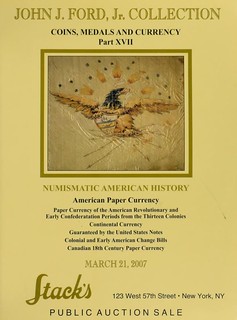 With the kind permission of Stack's Bowers Galleries, the Newman Numismatic Portal will be scanning the entire run of Stack's catalogs from
1935 to date. This is an ambitious project including over 600 individual catalogs, and the Newman Portal is grateful to Brian Kendrella, Q. David
Bowers, and Harvey Stack for their support in this endeavor.
With the kind permission of Stack's Bowers Galleries, the Newman Numismatic Portal will be scanning the entire run of Stack's catalogs from
1935 to date. This is an ambitious project including over 600 individual catalogs, and the Newman Portal is grateful to Brian Kendrella, Q. David
Bowers, and Harvey Stack for their support in this endeavor.
The first group, comprising the 24 Ford catalogs (2003 - 2013) is now available on the Newman Portal. The Ford sales encouraged collectors to explore American numismatics beyond federal coinage, and the superb offering of medals, colonials, and paper money revitalized interest in many of these areas. Meticulously catalogued by Michael Hodder and others, these catalogs are essential references detailing the wider panorama of American numismatics, and, through the courtesy of Stack's Bowers, are now just a few keystrokes away.
Link to John J. Ford, Jr. catalogs on the Newman Portal:
https://nnp.wustl.edu/library/auctioncompanydetail/3
NUMISMATICS INTERNATIONAL BULLETIN ONLINE
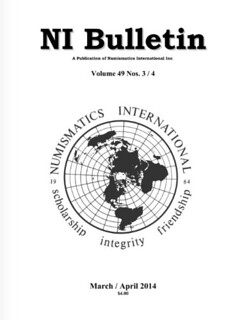 The Numismatics International Bulletin (NI Bulletin) was initially published in 1966, and has continued to be published on a regular
basis for over 50 years. It contains a wealth of important and scholarly information about various numismatic topics.
The Numismatics International Bulletin (NI Bulletin) was initially published in 1966, and has continued to be published on a regular
basis for over 50 years. It contains a wealth of important and scholarly information about various numismatic topics.
The NI Bulletins from the current year (2016) are available to members on the NI website (www.numis.org). However, the earlier issues, from 1966 to 2015, are only available in individual members' libraries or in the NI archives.
Although there has been an index available at the Yahoo Numismatics site, actual copies of articles were only available upon request from the NI archives, and then a copy could be sent. This was not an efficient way to make available to you the wealth of numismatic information.
The Newman Numismatic Portal (NNP), a non-profit organization housed at Washington University in St. Louis, has the goal to freely share a vast online store of both printed and virtual numismatic resources. Books, periodicals, as well as online forums and auction offerings are captured in one location, freely available, and searchable from anywhere in the world. This makes available unprecedented knowledge to collectors and researchers, to allow greater appreciation for numismatic science. It also allows more clear discernment of fact from fiction.
Numismatics International (NI) is now partnering with the Newman Numismatic Portal. NI has licensed NNP to allow NNP to share the NI Bulletin issues from 1966 through 2014. Topics can be searched, or whole issues of the NI Bulletin can be reviewed. This is a more efficient way to make available the huge amount of information which is in the NI archives. When more recent issues of the NI Bulletin are removed from the NI website, they will be made available at NNP.
We are excited that now NI is able to share its huge library of past NI Bulletins, with a treasure trove of numismatic information. It is now shared with others who have an interest in numismatics, and hopefully will consider joining NI to receive the current and more recent issues, and participate in other NI benefits.
If you wish to look at the older issues of the NI Bulletin, they can be found at
https://nnp.wustl.edu/library/publisherdetail/514285 .

AN AMERICAN SCHOOL OF ENGRAVING
The article on a School of Engraving in Europe in last week's E-Sylum prompts these comments.
To numismatists the word "engraving" means only one thing, engraving dies to strike coins, medals, tokens. In fact there are three kinds of engraving. The most common engraving is line engraving -- or surface engraving -- what is needed for printers' plates, to print currency, bonds, the technique for prints and for other uses.
Line engraving, also called “flat engraving” is in contrast to die engraving -- or relief engraving -- what is needed for dies to strike coins, medals, and tokens. To create dies an engraver is required to create the modulated relief which forms the depth of the design in the die, or the height of relief.
While line engraving is two dimension, die engraving is three dimensions. It is, of course, more difficult.
So how do engravers learn their craft? For the most part it is on the job training. An attempt to train young artists who wished to create coins and medals, Victor D. Brenner, in 1901, conducted a class at Cooper Union in New York City. He had just returned from a second trip to Paris, where he had studied with Louis Oscar Roty and others, and some at the Paris Mint. He had mastered the craft with training by the best medallists in the world at that time.
Brenner wanted to train others in the craft in America. Unfortunately we know of only one student in this class. If there were others none rose to prominence. His class was cancelled after this first year.
Later in the 20th century Americans who wanted such training had to go to Europe. The only school of this kind there was at the Italian national Mint in Rome, the Zecca di Stato which began such training in 1907. The most famous American alumnae of Zecca Mint training was Elizabeth Jones, who, of course is noted for becoming the Chief Engraver at the U.S. Mint.
Only three other Americans are known to have studied there, Virginia Janssen and Gary Eriksen (one of the founders of the American Medallic Sculpture Association). Neither of which are currently active. The third is Amanullah Haiderzad, who was an engraver at the Afghanistan Mint before he immigrated to America.
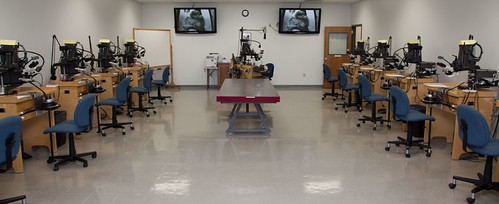
There is a unique American training center for engravers, very active, whose students are mainly trained for the jewelry industry, GRS in Emporia, Kansas. GRS students not only train to be jewelry engravers and gem setters, they also train for another somewhat of a cottage industry for engraving firearms for which there is a large demand for such on expensive pieces..
All this, again, is line engraving or surface engraving. GRS also sells the tools and equipment for the engraver, burins, vises, microscopes, anything used in the craft.
The most prominent student, well known in the numismatic field, is Ron Landis of Gallery Mint in Arkansas, who has high praise for GRS. Ron's skills, however, extend far beyond the line engraving taught at GRS. Known for his Hobo nickel creations, he can engrave dies just as well as surface engraving as evident by hundreds of both flat and relief kinds.
Ron is one of the few such hand engravers in America today. Franklin Mint, which commissioned over 150 medallic artists for their medallic productions, found only one such hand engraver.
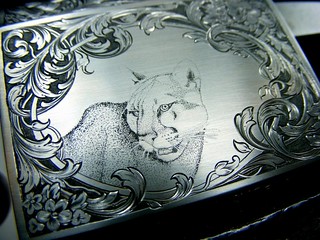
Now the third kind of engraving is little known in the numismatic field, bulino engraving. It is composed entirely of dots and by placing these near each other forms shading. It is used in the graphic arts and has no application to glyptic art necessary for die engraving.
If you wish to learn more about this type of engraving go to Adone Galleries. Here you will find illustrations of both line engraving and bulino engraving, in addition to a broad number of engraving tools: http://www.engravingarts.com/
To read the earlier E-Sylum article, see:
THE SCHOOL OF ENGRAVING (www.coinbooks.org/esylum_v19n46a32.html)
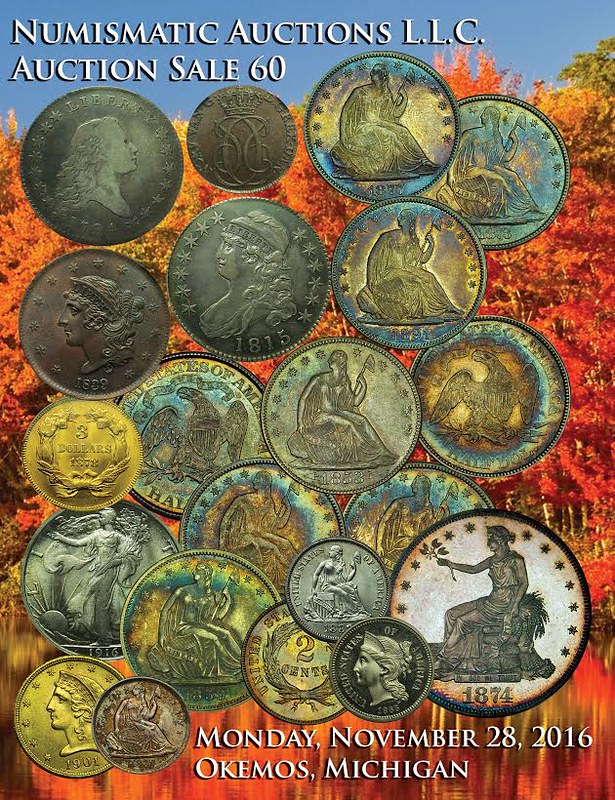
NOTES FROM E-SYLUM READERS: NOVEMBER 20, 2016
Linda Kolbe's Role in Numismatic Bibliomania
Joel Orosz writes:
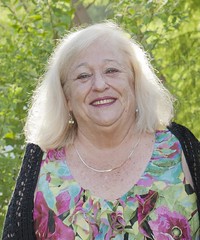 Linda Kolbe was the unsung hero of numismatic bibliomania in the United States. Without George Frederick Kolbe, there wouldn't have
been a numismatic literature hobby, or at least not one nearly so robust, but without Linda, there wouldn't have been a George. Linda was the
exemplar of the back-office worker, self-effacing, but so capable in so many ways that without her, George's business could not have taken off as
it did.
Linda Kolbe was the unsung hero of numismatic bibliomania in the United States. Without George Frederick Kolbe, there wouldn't have
been a numismatic literature hobby, or at least not one nearly so robust, but without Linda, there wouldn't have been a George. Linda was the
exemplar of the back-office worker, self-effacing, but so capable in so many ways that without her, George's business could not have taken off as
it did.
She rendered similarly unheralded, but equally essential, services to the Numismatic Bibliomania Society from its founding in 1979 through George's second stint as editor of The Asylum, ending in 1999. Those who were fortunate enough to be guests in the Kolbe home discovered that Linda epitomized the gracious hostess, and made all feel welcome, no matter how much the guest lived up to the "mania" part of our title.
We who collect literature about money owe this remarkable woman our respect and our gratitude, for upon the sturdy base of her quiet accomplishments rests so much of today's hobby. Linda, we mourn you, and will always miss you.
To read the earlier E-Sylum article, see:
LINDA KOLBE, 1942–2016 (www.coinbooks.org/esylum_v19n46a02.html)
Dick Johnson's Poem on Mint Packaging
Responding to Jeff Reichenberger's poem, Dick Johnson writes:
Enjoyed your poem, in lines quite pedantic;
Got the meaning intact, from lines quite semantic.
Had it not been your daughter, who found in the lauder,
A strawberry jelly roll, now removing proof glint.
You would have screamed all the packaging wrapped by the Mint.
Was not enough trouble, in plastic peanuts and bubbles.
In comments you raise all the way to the roof,
Their proof coin packaging was not enough to make it Child Proof.
To read the earlier E-Sylum article, see:
JEFF REICHENBERGER ON U.S. MINT PACKAGING (www.coinbooks.org/esylum_v19n46a28.html)
Query: George B. Gillin Information Sought
Bruce W. Smith writes:
I am looking for information on George B. Gillin, who was superintendent of the San Francisco Mint. Google search hasn't turned up much on him, except that he resigned the position rather then being removed, because he was operating an insurance business on the side.
The old Coin World Almanac says he held office from 1 July 1948 through 30 November 1951, when he resigned. I would like to know his dates (birth and death), what he did before and after his mint job, and what qualifications if any he had for the job.
I think he was born about 1896 and his father may have had the same name. There was another George B. Gillin in San Francisco who was in the University of California class of 1875 (or maybe 1885). Any help? Thanks.
From the Numismatic Gallery Monthly, January 1950, Page 8:
HON. GEORGE B. GILLIN, Supt. of San Francisco Mint, is really swell; recently had the Junior Coin Collectors of San Francisco, East Bay & Peninsula Clubs, under Roy Hill's leadership, at the Mint. MR. GILLIN was responsible for the ANA tour during the Convention.
To read the issue on the Newman Portal, see:
https://nnp.wustl.edu/library/book/517460?page=7
Alan Weinberg On Gold Medals
Alan Weinberg writes:
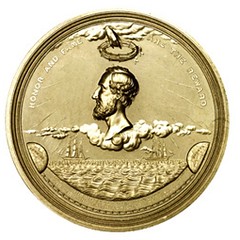 I own the unique gold US Mint-struck Cyrus Field Congressional medal acquired perhaps 30 years ago from the late coin dealer Cy Phillips
Temple City, CA.
I own the unique gold US Mint-struck Cyrus Field Congressional medal acquired perhaps 30 years ago from the late coin dealer Cy Phillips
Temple City, CA.
And perhaps 40 years ago Dave Schenkman offered me a Andrew Carnegie lifesaving gold medal for around $8-10,000 but I declined due to rim dents. I doubt the gold fireman's gold Carnegie Hero medal would be worth $50,000 - let alone $100,000 - as it is easily acquired in silver and quite plentiful in bronze which impacts its value and desirability in gold.. These appraisal fairs usually appraise on the extremely high side for publicity and to please the owner.
To read the earlier E-Sylum articles, see:
THE CYRUS FIELD MEDAL (www.coinbooks.org/esylum_v19n46a23.html)
MILWAUKEE GOLD CARNEGIE HERO MEDAL APPRAISED
(www.coinbooks.org/esylum_v19n46a24.html)
Is Book Curse Quote a Hoax?
Frm last week's article on book curses:
“For him that stealeth, or borroweth and returneth not, this book from its owner, let it change into a serpent in his hand & rend him. Let him be struck with palsy & all his members blasted. Let him languish in pain crying aloud for mercy, & let there be no surcease to his agony till he sing in dissolution. Let bookworms gnaw his entrails in token of the Worm that dieth not, & when at last he goeth to his final punishment, let the flames of Hell consume him for ever.”
Bill Eckberg writes:
Of course, he doth not “sing” into dissolution, but rather “sink.”
I am told that this charming curse does not date to the Middle Ages. I have a lovely, hand-printed version of it (in a slightly different form) on the wall in my office. It is undated, but was purchased from the artist in the late 1970s-early 1980s. The quote is alleged to be from “The Monastery of San Pedro, Barcelona.” The artist, herself, told me that the story is entirely apocryphal. However, Snopes.com seems not to be aware of such a quote.
To read the earlier E-Sylum article, see:
THE HISTORY OF BOOK CURSES (www.coinbooks.org/esylum_v19n46a46.html)
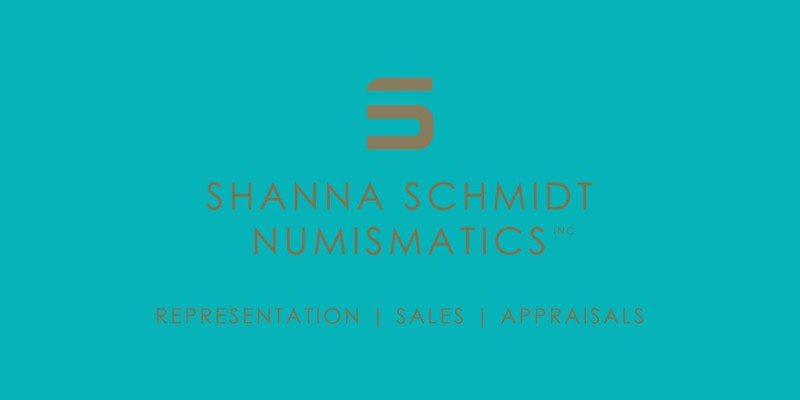
DAVID LANGE'S COIN ALBUM MUSEUM
It was interesting that you included an article about "Very Specific Museums" in the recent issue. This must be a hot topic these days, as one of my favorite websites, MessyNessyChic.com, recently ran a piece about oddball museums.
Of course, I have my own Coin Album Museum in my home. While I don't charge admission and don't advertise, I have had a few visitors over the years. The most recent were a couple from Iowa who were down in Florida scoping out places to retire. He's a fairly new collector of coin boards, and they both enjoyed the tour. He ended up buying four boards from me that he plans to use for storing his coins. I always have mixed feelings about that, but the boards weren't rare enough that a little extra wear and tear would cripple the outstanding population.
I'm attaching some photos I took of my collection after recently tidying it up. There were piles of things all around the floor, many of them more modern pieces and odds and ends that were better stored in totes. I've done this, and now the closets are full, too.
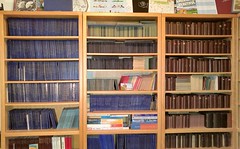
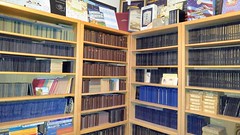
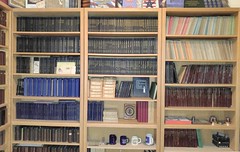
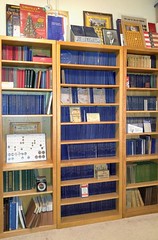
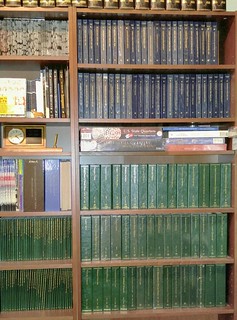
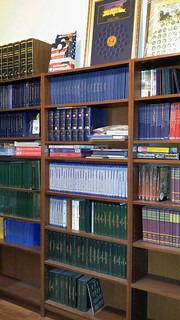
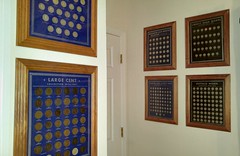
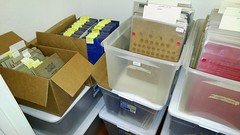
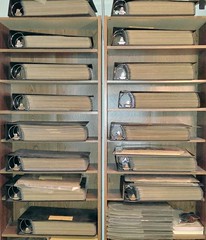
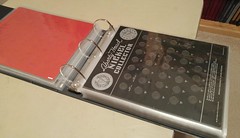
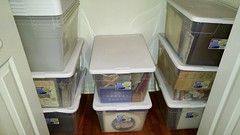

To read the earlier E-Sylum article, see:
VERY SPECIFIC MUSEUMS (www.coinbooks.org/esylum_v19n46a20.html)
MERCANTI'S FIRST LOOK
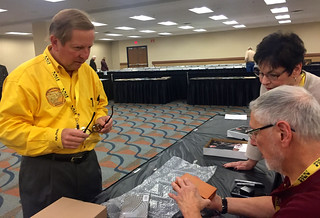
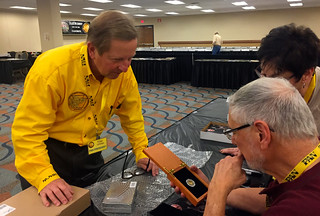
PAN President and CCAC member Tom Uram received a FedEx package and wanted retired U.S. Mint 12th Chief Engraver John Mercanti to be the one to open it during his visit to the PAN Fall Coin Show on Friday October 28, 2016. John and his wife Marianne were sitting at the PAN book signing table when Tom approached and asked if he wouldn't mind because he would surly be interested in the contents.
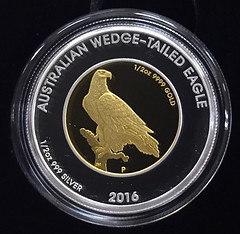
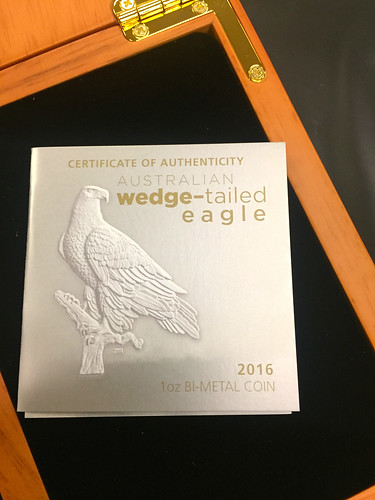
John carefully peeled away the packing and was surprised to see that it was the delayed release Australian Wedge-tailed Eagle 2016 Bi-metal Coin from The Perth Mint that he was contracted to design. Mr. Mercanti had not seen his finished creation. Only a few firms had the coin available for sale and Tom was able to acquire this one from a German company. John and Marianne were quite drawn to how beautiful the finished product had turned out.
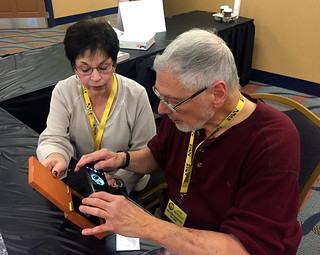
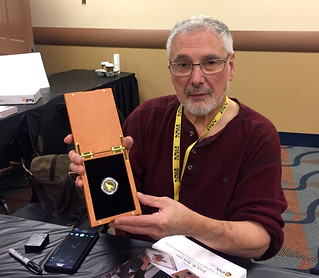
John has been doing work for the Perth Mint since his retirement from the U.S. Mint. He remarked how delighted he has been at the popularity of his wedge tailed eagle designs on previous silver coins from the Perth Mint. The look on Mr. and Mrs. Mercanti's faces was wonderful to catch. The majestic eagle perched in a .999 gold centerpiece with the .999 silver border includes the inscription AUSTRALIAN WEDGE-TAILED EAGLE, the 2016 year-date and The Perth Mint's ‘P' mintmark was beyond his expectations with a commanding elegance, simplicity, and beauty.
The bi-metal coin depicts the Ian Rank-Broadley effigy of Her Majesty Queen Elizabeth II and the monetary denomination on the obverse.
PAN invited John to be a guest at the coin show to honor his American Silver Eagle design on the 30th anniversary of the popular silver bullion coin. As with any birthday celebration, it is very nice to open a package and PAN was fortunate to be the venue for the birthday surprise. Just to be clear Tom kept his coin.
There is a limited mintage of only 750 and they are pricey. The Perth Mint has put out a very creative product in the bi-metal silver and gold and clearly recognizes John Mercanti's artistic talent. There are some available through the larger coin company distributers. The cost for the 1/2 oz silver, 1/2 oz gold is somewhere in the $1,700 range. John will have to buy his own.
For more informtion on PAN, see:
http://pancoins.org/
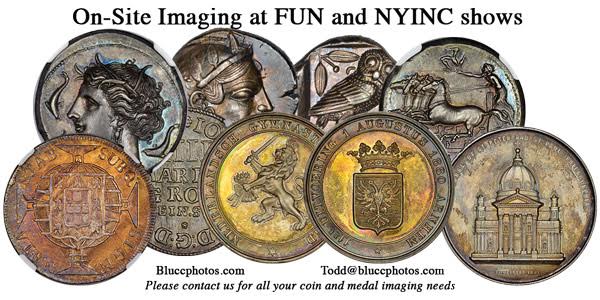
VOCABULARY TERM: BURIN
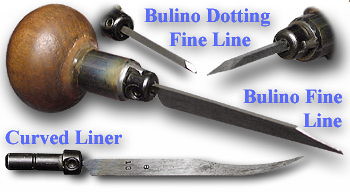
All kinds of engraving is accomplished with the engraver's basic tool, the burin, also called a “graver.” A shaft of steel is sharpened at the end in one of a dozen diamond shapes to cut different shapes. The shaft is inserted in a wooden handle, also of different shapes to suit the engraver's hand. Dies are also cut with other tools.
Burin. An engraving tool with a diamond or lozenge shaped cutting edge, often used for engraving lines, lettering or
fine detail in dies. Burins are made of tempered steel with an oblique cutting edge shaped in such a way that light pressure cuts a thin line,
heavier pressure cuts a wider and deeper channel. The flared cutting edge also has the advantage in that any cut made in a die has an automatic
BEVEL, necessary for any striking work (the die can strike and withdraw without the piece "hanging up"). A burin is also frequently used
for INSCRIBING a medal after it has been struck, burins are used for script style lettering requiring narrow strokes and wide stems. Burins are also
called lozenge or diamond point graver. See GRAVER, ENGRAVING.
CLASS 04.1
HORACE MAITLAND GRANT (1873-1960)
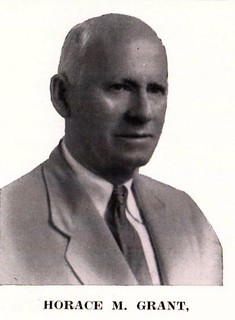 Horace Maitland Grant (1873-1960), was born January 24, 1873 at Bellingham, Norfolk County, Massachusetts. Grant was an innovative coin and
stamp dealer for thirty-seven years from 1921 to 1958.
Horace Maitland Grant (1873-1960), was born January 24, 1873 at Bellingham, Norfolk County, Massachusetts. Grant was an innovative coin and
stamp dealer for thirty-seven years from 1921 to 1958.
Born the son of Eldridge [Ellridge] Grant (1846-) and Elizabeth T. Rockwood Grant at Bellingham, Massachusetts. His father was a retail grocer who owned a general store in Bellingham according to the 1880 Census. He began collecting coins in 1885 at the age of twelve. Horace would relate later in life how as a boy he would cherry pick rare coins from his father's cash box at the store. His first coin collection was stolen when he was 15 years old in 1888 comprising mainly Early American Copper half cents and large cents and U. S. silver coins.
According to the family records his father also ran a post office within the store as Postmaster, and young Horace was the Assistant Postmaster. Resulting from this office he amassed a whole peck filled with encased postage stamps. His coin collecting began by selecting coins that came over the counter in his father's store, which he was allowed to keep. In the 1920's he worked at his company Selected Electric Appliance Company of Providence Rhode Island. With a career in the electrical appliance industry he clung to coin and stamp collecting and developed an interest in buying and selling as a dealer.
In 1900 he lived at Dean Avenue, Franklin, Massachusetts and worked as an Express Agent. According to his 1918 Draft Card he lived at 38 Norwich Avenue, Providence, Rhode Island, and was the General Manager manager of Grant Vacuum Cleaner & Sales Agency.
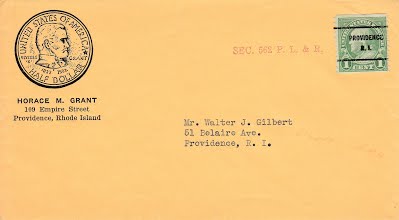
Grant was a member of the ANS and was also ANA Member No. 2239, having joined in 1921 and still living at 38 Norwich Avenue, Providence, Rhode Island. Beginning about 1923 opened his hobby shop at 109 Empire Street, Providence, Rhode Island...
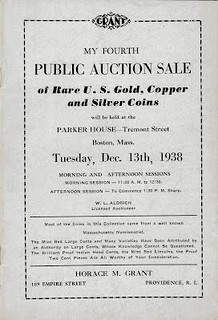
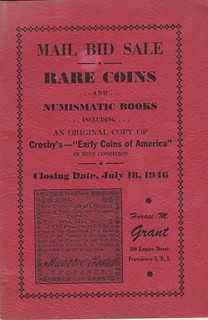
The 1946 Mail Bid sale included an original
copy of Crosby's Early Coins of America.
He began publishing half page ads in The Numismatist in June 1929. In 1930 he acquired a black walnut loving cup made in the 1790's that was inlaid with coins from the 1790's to the late 1920's all uncirculated. A photograph of this cup was published in The Numismatist in March 1930, page 152.
He founded The Hobby Shop on Empire Street, Providence, Rhode Island. He ran coin auctions by mail bids beginning in March 1938. Remy Bourne published the photograph of Grant's Hobby Shop, August 1936 Fixed Price List of U. S. Commemoratives.
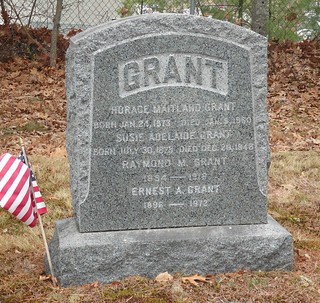 He retired in 1958 and the business was taken over by his son and co-worker Ernest A. Grant operating coin auction sales at Grant's
Hobby Shop. The first auction was held on May 30, 1958 with Towne Coin Company. Two more auctions were held in October 1959 and posthumously to
Horace Grant on October 15, 1960. Ernest gave talks and presentations on coins at various clubs including the Newport County Coin Club in 1962. He
died of Bronchopneumonia and Coronary Sclerosis on January 9, 1960 at the Roger Williams General Hospital, Rhode Island.
He retired in 1958 and the business was taken over by his son and co-worker Ernest A. Grant operating coin auction sales at Grant's
Hobby Shop. The first auction was held on May 30, 1958 with Towne Coin Company. Two more auctions were held in October 1959 and posthumously to
Horace Grant on October 15, 1960. Ernest gave talks and presentations on coins at various clubs including the Newport County Coin Club in 1962. He
died of Bronchopneumonia and Coronary Sclerosis on January 9, 1960 at the Roger Williams General Hospital, Rhode Island.
To read the complete article, see:
GRANT, HORACE MAITLAND
(https://sites.google.com/a/numismaticmall.com/www/numismaticmall-com/grant-horace-maitland)
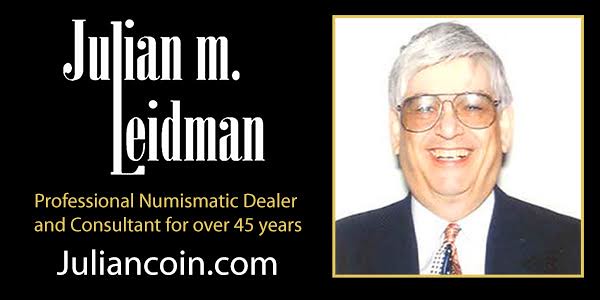
MELVIN JONES: BESIDE HIMSELF
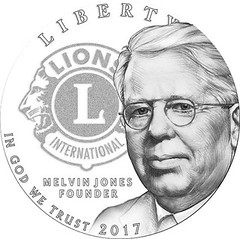 The Joel Iskowitz design for the obverse of the 2017 Lions Int'l Centennial Silver Dollar is not the first portrait of Melvin Jones to
appear in metal. This is the Iskowitz obverse.
The Joel Iskowitz design for the obverse of the 2017 Lions Int'l Centennial Silver Dollar is not the first portrait of Melvin Jones to
appear in metal. This is the Iskowitz obverse.
It will be interesting to see how this design translates into bas-relief as sculpted by Joseph F. Menna. The Coin World video of the First Strike Ceremony at the Philadelphia Mint did not give a clear close-up of the obverse. There was just the white glove proof picture captured from the video. So far I have not found still pictures of the actual coin from the US Mint. I believe it will be 2017 and the release of the silver dollar before the public will see the coin in dimension.
In 1937, the Chicago chapter of Lions Int'l issued a bronze medal bearing a portrait of Melvin Jones to celebrate the 20th Anniversary of the service organization. In 1950, Lions Clubs Int'l itself commissioned another portrait of Jones, this time to celebrate the naming of Melvin Jones (1879-1961) as Secretary General for Life. For quite a few years after the death of the founder, this uniface portrait medal was used as an incentive premium to increase Lions Clubs membership enrollment.
The same sculptor did both the 1937 and the 1950 medals, Here they are side by side.
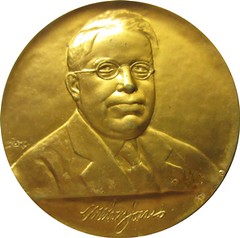
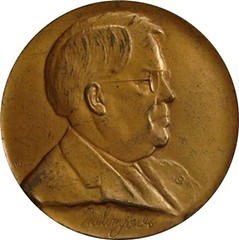
Both medals were struck by The Robbins Co. and sculpted by Julio Kilenyi during his tenure as a consulting Art Director for Robbins. This is a rare example in the 20th century of the same sculptor dong full face and profile bas-relief portraits of the same subject. And I often think this is the only time this philanthropic leader and do-gooder had his mug shots taken.
To read the earlier E-Sylum article, see:
2017 LIONS CLUBS DOLLAR FIRST STRIKE CEREMONY
(/www.coinbooks.org/esylum_v19n46a27.html)
THE HOODOO HALF DOLLAR
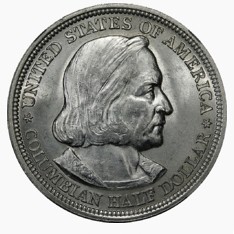 The foreboding headline over the March 27, 1904 Times article reads, “The Trail Of Disaster Behind A ‘Hoodoo' Coin: Whosoever Finds This
Harbinger of Ill, Let Him Throw it Into the River.”
The foreboding headline over the March 27, 1904 Times article reads, “The Trail Of Disaster Behind A ‘Hoodoo' Coin: Whosoever Finds This
Harbinger of Ill, Let Him Throw it Into the River.”
The article warned: “If you possess a Columbian half dollar, if you have been carefully pocketing it as a souvenir and can look back over a trail of inconceivable hard luck, then rid yourself of the coin and witness your rise into a normal condition of life.
“Somewhere in the United States this Columbian half dollar is dealing destruction—perhaps death.”
The article related that in 1892 there had been a little card game in Pittsburgh. “Charley” McSwiggan, “until recently press representative of the Carnegie Steel Corporation,” had for weeks been invincible. “Nightly did he clean the table, stake his friends with carfare, and then bolt for an all-night conveyance to his suburban home.”
In time, he journeyed to New York, where one day he stopped by the Sub-Treasury and purchased one of the new Columbian half dollars. “McSwiggan's diary shows that from that minute his god of good fortune deserted him. He went to the Sheepshead track. The ‘bookies' hit him hard. He rode on a Broadway car, and a pickpocket pumped him dry.” After which, “he boarded a train for Pittsburg[h] with a railroad ticket, a pain-racking hunger, and his Columbian half dollar.”
Several weeks later, McSwiggan was back in the game in Pittsburgh, but was “now the ‘easiest money' they had ever known.” Every time he sat down to play, he was separated from all of his money except the Columbian half dollar. “Finally he said he had lost faith in his mascot. He played it in. Presto! He picked up instantly.”
But at the end of the night he redeemed the half dollar and took it away with him. The next game the sequence repeated—as soon as he was rid of the half, his luck returned. He finally abandoned the coin, which each player took a turn owning with the same negative result. Eventually, the coin wound up in the pocket of dead man named Jope, “who had been murdered, beaten to death, in the cellar of the First Avenue Hotel.”
To read the complete article, see:
Hoodoo half dollar (www.numismaticnews.net/article/hoodoo-half-dollar)
SELECTIONS FROM NUMISMATIC AUCTIONS SALE 60
Lot 49: Large Cent Collection Assembled in 1879
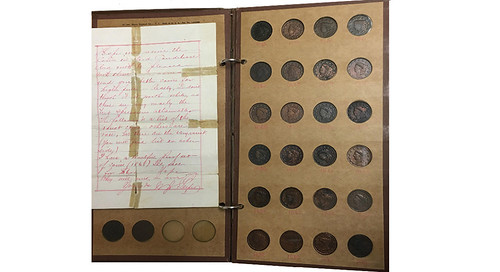
Large Cent Collection Assembled in 1879, 1816-1857 Complete. This remarkable collection of large cents was purchased by Herman M. Atwood from Philadelphia dealer W.J. Peiper in 1879. The early dates (1793-1814) have been removed from this set and listed above as either single or multiple coin lots (Lot Nos. 11-15, 17-23, 25-28 & 30-32). The collection is housed in vintage Wayte Raymond boards(3) and held within a National Coin Album. A 4-page letter, 7.75 x 10.25 inches, from Peiper to Atwood accompanies this lot.
Datelined “Philada, 3/19/(18)79” Peiper writes
“...Dear Sir, Your order has been filled. Allow me to add a few remarks. The 1793 Chain Ameri(not present) was very hard to obtain. I only could get one. I'll send you another in the course of a week - Also the 1804 - I sent one - its cheapness owing to its condition - to get you a fine one would cost $10 to $20 and this will answer for the present. I'll send another with the 1793 next week. I could not get a Common 1799 - The best cost $25 - am sorry I could not get you one...I could send you better coins for higher prices...The following is a list of the rarest coins - others are rare, but these are the very rarest...I have a beautiful Proof set of coins (1868) I'll sell for $6.00...W.J. Piper”
The two inner pages list the rare coins including an 1856 Nickel Penny for $3.25, as well as a list of the early date large cents and their cost. The letter itself is in Very Good condition with aged cello tape at the folds, fold seps. The Middle Date Large Cents, 1816-1839 (one each date) grade aVG to aEF, with an average of VG-Fine, some clnd long ago or with the typical problems encountered. The Late Date Large Cents, 1840-1857 (one each date) grade Fine to EF, average nearly VF, some clnd long ago or with problems. The coins have not been attributed. Nice opportunity for the collector to own a collection assembled during the 19th century and later housed in a vintage coin album. 42 Large Cents + Album + 1879 Letter.
Lot 215: 1794 Flowing Hair Half Dollar
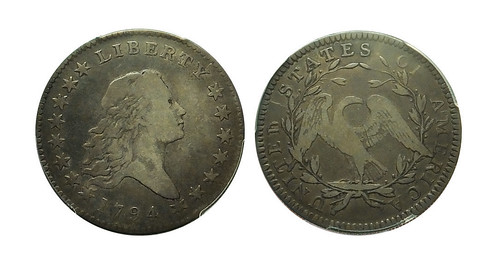
1794 Flowing Hair Half Dollar. O-101. PCGS Fine15, cpl lt old mks rev, original and appealing. A classic first year of issue rarity, a wonderful example of our earliest United States Half Dollar coin!
Lot 256: 1873/3 Half Dollar. Closed 3, No Arrows.
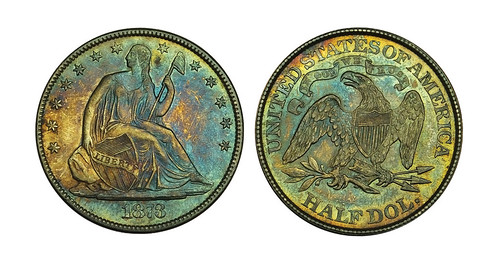
1873/3. Closed 3, No Arrows. Iridescent steel blue, violet and golden toned Choice AU-Unc. Beautiful!
Lot 310: 1874 Trade Dollar
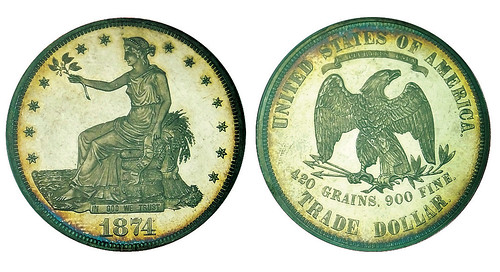
1874. PCGS PR64CAM. Very appealing with strong cameo contrast and lt colorful rim toning, a large price point move in 65CAM makes this example even more alluring.
Lot 493: 1881 Nickel Three Cents Pattern
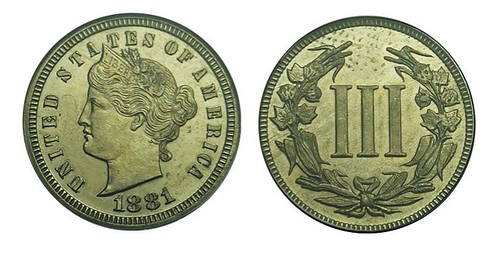
Nickel Three Cents Pattern, 1881. Judd-1668. NGC PF64 and very attractive. An outstanding example of crossover design element experimentation and seldom offered
Lot 537: Accommodation Paper 50 Cents Scrip
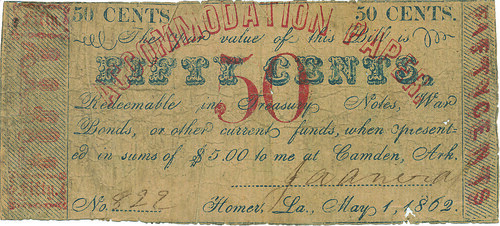
Obsolete Currency. Camden, Arkansas & Homer, Louisiana – Accommodation Paper 50 Cents. May 1, 1862. Fine+,
Lot 556: 1841 Hard Times Token - Daniel Webster
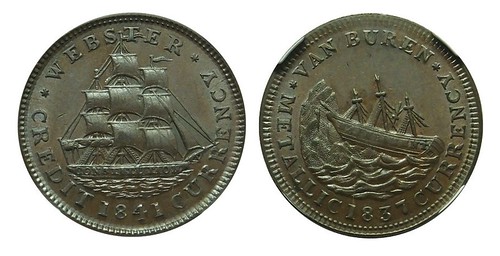
Daniel Webster, 1841. HT-22. NGC MS64BN. Nice color and very attractive, tough in high grade.
Lot 558: Alaska Rural Rehabilitation Corporation Tokens
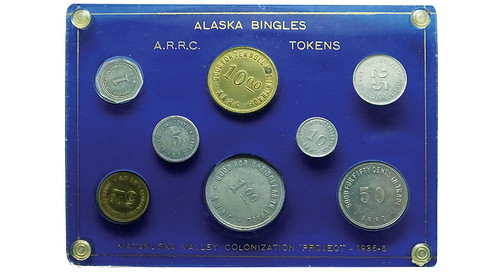
Alaska Rural Rehabilitation Corporation Tokens, 1935. Complete Set. Includes 1, 5, 10, 25, 50 Cents plus $1 in aluminum and $5 and $10 in brass. Tokens average EF condition, the aluminum w/ semi-reflective fields, the $10 brass token w/ two spots of oxidation on one side. Nicely housed in a gilt blue Capital Plastics holder (crack on back). Mintage ranges from 2500-5000 pieces for the aluminum and just 1000 pieces for the $5 & $10 tokens. These tokens were issued by the U.S. Government for the use of the Midwesterners who relocated to Alaska as part of the Matanuska Valley Colonization project. Very scarce as a complete Set. Well matched. 8 tokens
Lot 564: Official Prize Medal
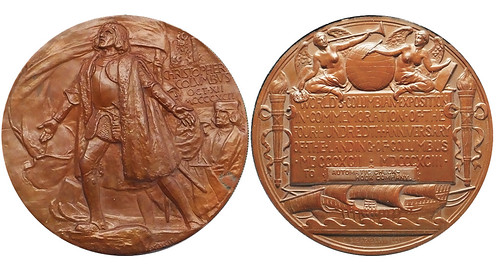
Official Prize Medal. AE, 76mm, by A. St. Gaudens & C. Barber. Eglit 90; Rulau X3. Awarded to “AUTOMATIC CHECK- / HOOK COMPANY.” Lovely AU-Unc with mahogany patina. Accompanied by its original deep blue velvet lined aluminum box with fine floral design. Scarce thus
Lot 576: 1909 Portola Festival Dollar
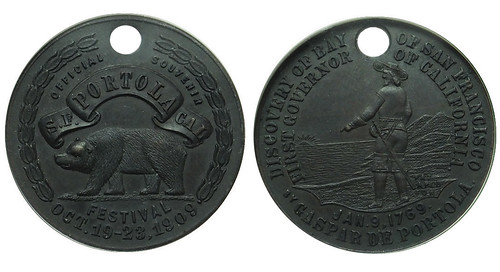
San Francisco, CA – Portola Festival Dollar, 1909. HK 389. NGC MS65BN, pierced for suspension as typical for the issue. Very seldom offered and Pop 1 in this grade!
Lot 787: Ceylon. Chola Dynasty
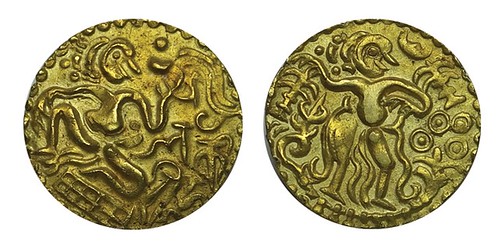
Ceylon. Chola Dynasty. Anonymous AV Kahavanu, ND (c. 980- 1070 AD). 22m
Lot 916: 1809 Ceylon 96 Stivers
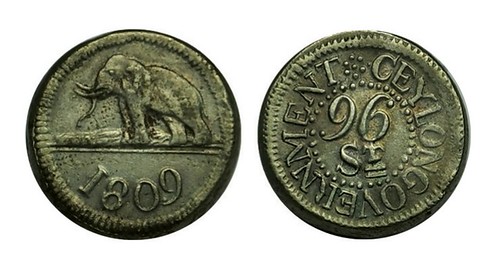
96 Stivers, 1809. KM-79, Pridmore-2. Choice VF-EF, some small flan flaws on edge, otherwise nice. Ex: Randolph Zander.
To read the complete auction catalog, see:
http://numismaticauctionsllc.com/uploads/
Sale_60_Interactive_PDF.pdf
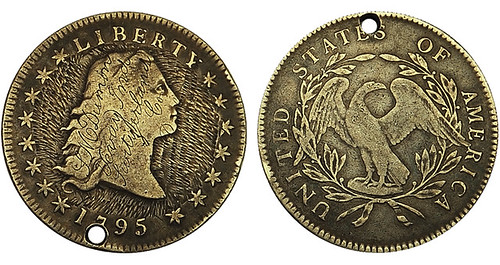
Another fascinating lot is a 1795 Flowing Hair dollar with an extensively engraved obverse that reads, “L.M. Dumon, Vevay, Ind., Switzerland Co.,” in cursive with scribed texture in the obverse fields.
Vevay is the county seat of Switzerland County in Indiana and its population was 1,683 at the 2010 census. The dollar comes from the Myron Xenos – Money Tree Collection and has Very Fine details. A hole is noted under the 7 in the date relative to the obverse.
The “Love token,” which seems to serve a more functional or commemorative versus a romantic purpose, provides an opportunity for a budget-minded collector to add this challenging type coin to his or her collection.
To read the complete article, see:
Large cents from collection
created in 1879, engraved silver dollar highlight auction
(www.coinworld.com/news/us-coins/2016/11/large-cents-from-1879-collection-highlights-auction.html#)
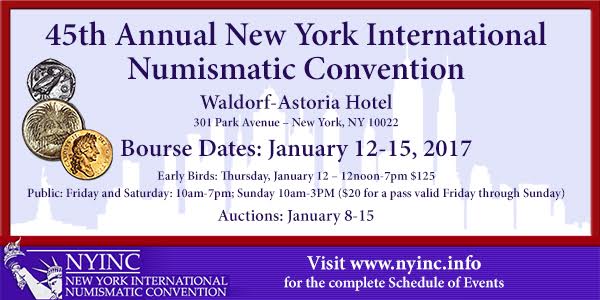
DONALD YOUNG EXONUMIA IN HOLABIRD SALE
Bill Hyder submitted the following article which will also appear (with more images) in the upcoming TAMS Journal about the auction of Don Young's exonumia collection by Fred Holabird in December. Thanks!
TAMS = Token and Medal Society
ANA = American Numismatic Association -Editor
I had the opportunity to help catalog Donald Young's exonumia collection slated for auction by Holabird Western Americana Collections in their December 9, 10, and 11 auction. Many of you are familiar with Don and some of you may have known the extent of his collection. For me, it was a pleasant surprise and now TAMS members have an opportunity to add to their own collections. Don collected with an eye to quality. If you want a catalog, call 775-851-1859 and let them know you are a TAMS member. In addition to mail bids and bidding live in Reno, you can also participate live through several online options. These are discussed at the end of the article.
We receive requests from TAMS members interested in how they might go about collecting TAMS assembly medals as well as presidential medals. One can search eBay and dealer tables at shows, but most medals are relatively low value when purchased individually and can be difficult to find. Don kept most of his collection in Dansco albums and these will be auctioned as he kept them, one album at a time. In the albums, you will find bronze and silver presidential medals, progression sets of Don's presidential medal, and gold plated, gold-filled, and 14k gold examples of some of the presidential medals presented to the presidents.
In some years, sets of the assembly medals were struck in different metals and presented to the medal's designer. Limited numbers of the sets were produced and those represented in Don's collection from 2000 through 2009 will be sold as well. Virginia Culver's gold literary award is among the more surprising and more expensive pieces we found in the collection. Lead trial strikes and rejected medal designs are sprinkled through the auction lots as well. TAMS collectors will want to read the descriptions carefully and call for more information if needed prior to bidding.
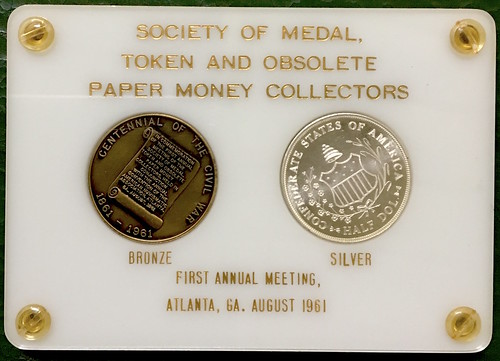
The first assembly medal issued in 1961 caught my eye. Examples are found in one of Don's albums, but a set in a capital plastics holder caught my eye. It was in a box of mixed medals because the label on the holder said, SOCIETY OF MEDAL, TOKEN AND OBSOLETE PAPER MONEY COLLECTORS. It took me a moment to realize that it was indeed the first issue of TAMS. The medal was conceived by Roy C. Small, designed by the Shawnee Hills Medallists of Harrisburg, Illinois, and engraved by Robert B. Barron. William Bryant of Wendell-Northwestern in Minneapolis arranged to have the medal struck at minimal cost to the society. All paid members received a bronze copy of the medal and one silver medal per member could be ordered for $3.00 prior to the first annual meeting at the ANA convention in Atlanta.
Don specialized in ANA badges, medal sets, and an amazing collection of 25th, 50th, and 60th year anniversary medals, appreciation medals, and award medals. Awards presented to Vernon Sheldon, Abe Kosoff, and Robert Hendershott are among the more prominent names represented as well as gold presidential medals for J. Henri Ripstra, Virginia Culver, George D. Hatie, and Vernon Sheldon.
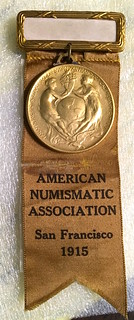
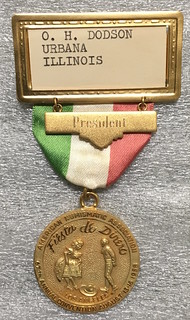
The highlight of Don's ANA exonumia is the complete ANA badge collection with all the early examples in pristine, as new condition. The one example in less than ideal condition are two examples of the 1915 San Francisco badge, a piece missing in virtually every major collection. One of the two 1915 badges is an unknown Reception Committee badge. The name bar and medal are somewhat corroded and the ribbon is separate from the pin bar, but it is intact and easily repaired.
The first ANA badge was issued in 1908 and Don's example is flawless. But, a celluloid pin back was distributed in 1907 to promote the idea of issuing badges. Three examples of the 1907 bin back will be offered in the auction.
The 1913 Detroit ANA convention badge is a good example of the quality of the early badges. Detroit Civil War store cards were used as hangers on the ribbon. The B.N. Kneeland Stoves store card (MN-225-AR) was used on the badge presented here. The Civil War token is one of the more famous spelling errors, STOEVS. It is a beautiful badge with an uncirculated store card.
Among the other rare badges is the 1918 Philadelphia badge that was never issued and the convention was cancelled owing to a flu epidemic. Examples of the badge were thought to not exist, but did come to light when Neil Harris was writing his study of ANA convention badges for The Numismatist. Again, this badge and the two 1919 badges that accompany it are of the highest quality.
There are other surprises in the collection including two sets of the 1946 Davenport, Iowa convention medals including gold versions of the medal. Both sets are in the original gold colored boxes of issue. Another surprise is five gold badges from the 1958 Los Angeles ANA convention that were issued to ANA officers and committee members. Virtually every convention medal issued by the ANA is represented including many if not most of the gold versions of the medals when issued. Of special note are five silver examples of the large 75th Anniversary medals struck by the US Mint including the one presented to mint director Eva Adams. Only 30 of these medals were struck and it is believed only 28 were actually released for presentation. If you have been looking for this rare medal, you have a chance at one of five different copies.
Central States Numismatic Society collectors will find a long run of badges and medals dating back to 1953. Many of the early medals are from the estates of Glenn Smedley and George Hatie. Nine sets of progression strikes of high relief large and small medals along with lead die trials of many medals are included in the auction.
Medals collectors will find a number of items of interest including large calendar medals, Medal Collectors of America sets, FIDEM medals, and a variety of miscellaneous art medals. A long run (34 total) of Brookgreen Gardens medals is sure to be popular.
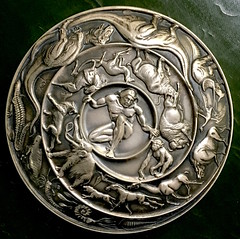 Don's collection of the Circle of Friends of the Medallion and Society of Medalists issues are another highlight of the auction. All twelve
books and medals in the CoM set are included, as well as the large 1993 silver restrike of Victor D. Brenner's Motherhood medal. Eighty-eight Society
of Medalists issues turned out to be the surprise of the collection. With the exception of the 1994 set of 6 dinosaur medals, the other 82 medals are
rare silver examples of the series. The first seventy issues in silver represent an exceptional collection in and of themselves. There are no mintage
figures for numbers 41 through 70 and many of these are undoubtedly rarer than other silver issues. The impressive 1990 Creation medal by Marcel
Jovine is even more impressive in silver. The medal required over a hundred strikes and twenty separate annealings to produce. The silver medal
contains nineteen ounces of silver. Equally impressive is the 1995 Last Supper medal by Geri Jimenez Gould struck in silver. The 155mm x 79mm medal
is the largest in the set.
Don's collection of the Circle of Friends of the Medallion and Society of Medalists issues are another highlight of the auction. All twelve
books and medals in the CoM set are included, as well as the large 1993 silver restrike of Victor D. Brenner's Motherhood medal. Eighty-eight Society
of Medalists issues turned out to be the surprise of the collection. With the exception of the 1994 set of 6 dinosaur medals, the other 82 medals are
rare silver examples of the series. The first seventy issues in silver represent an exceptional collection in and of themselves. There are no mintage
figures for numbers 41 through 70 and many of these are undoubtedly rarer than other silver issues. The impressive 1990 Creation medal by Marcel
Jovine is even more impressive in silver. The medal required over a hundred strikes and twenty separate annealings to produce. The silver medal
contains nineteen ounces of silver. Equally impressive is the 1995 Last Supper medal by Geri Jimenez Gould struck in silver. The 155mm x 79mm medal
is the largest in the set.
TAMS members may request a copy of the catalog by calling 775-851-1859 or 844-HWAC-RNO (492-2766) or email Info@holabirdamericana.com. Don's collection is scheduled to appear in the December auction, currently scheduled to run December 9, 10, and 11th. The latest information is available on their web site, http://holabirdamericana.com/. Bidders can participate by phone if there are lots that you want to be sure to buy. If you want to participate or follow the entire auction (or even just the Dan Young section), you can register and bid via ICollector (http://www.icollector.com/, look for Holabird auctions). Other online options include Invaluable (they add a bidder fee), AuctionZip, and eBay (live). AuctionMobility is an iPad and iPhone application that others are finding useful as well.
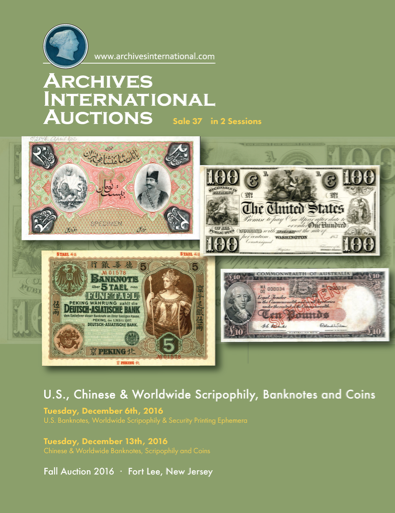
ARCHIVES INTERNATIONAL DECEMBER 2016 SALE
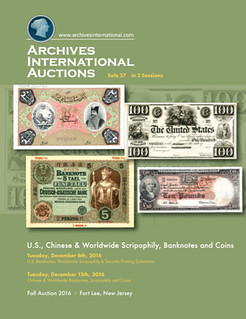 A discovery collection of 1930s-era Chinese Communist banknote rarities, acquired by an American collector who spent time in China in the
early 1970's when China was beginning to have a more open policy, will be part of a two-session public auction planned for December 6 th and 13 th by
Archives International Auctions, at 1580 Lemoine Avenue in Fort Lee.
A discovery collection of 1930s-era Chinese Communist banknote rarities, acquired by an American collector who spent time in China in the
early 1970's when China was beginning to have a more open policy, will be part of a two-session public auction planned for December 6 th and 13 th by
Archives International Auctions, at 1580 Lemoine Avenue in Fort Lee.
The auction will be packed with over 1,100 lots of rare and highly collectible Chinese, U.S. and worldwide banknotes, scripophily (stock and bond certificates) and coins. The first session, Dec. 6, will have nearly 500 lots of U.S. banknotes, scripophily and security printing ephemera. The second session, Dec. 13, will include Chinese and worldwide banknotes, scripophily and coins.
Start times both back-to- back Tuesdays will be 10:30 am Eastern time. For those unable to attend in person, online bidding will be available through the website, www.ArchivesInternational.com.
“We're proud to be able to offer an outstanding collection of worldwide banknotes featuring many rarities that have not been offered to the public previously at auction, as well as two advanced collectors' consignments that will be sure to attract serious attention from both collectors and dealers,” said Dr. Robert Schwartz, president of Archives International Auctions.
Dr. Schwartz added, “We're also looking forward to our first winter auction, slated for February 2017 and are in the planning stages for our Spring and summer 2017 auctions. These sales will include the final portion of the Alexander I. Pogrebetsky Family Archives, which we are very excited to offer, plus other offerings in many categories.”
Session 1, on December 6 th will feature 484 lots of U.S. and worldwide banknotes and scripophily, highlighted by a U.S. $100 Act of October 12th, 1837 interest bearing proof Treasury note from the Silver City Collection (one of three discovered); two lots of First Liberty Loan Bonds of 1917; a U.S. Department of the Interior - Federal Related Cherokee Nation, 1894 specimen bond financing the purchase of the “Cherokee Outlet, Oklahoma Territory”; and over 50 lots of U.S. obsolete banknotes; and hundreds of desirable and attractive bonds and shares.
Session 2, on Tuesday, December 13 th , will begin with over 200 lots of Chinese banknotes, to include the 1930s-era Communist Chinese issue rarities, plus a Bank of Communications, 1913 'Hunan' branch issue discovery note; a 5 Taels, Deutsch-Asiatische Bank, 1907 "Peking" branch high grade rarity; and a £10 Commonwealth of Australia, ND (1954-59) specimen note rarity.
The session will continue with a Dominican Republic, Banco De La Compania De Credito De Puerto Plata, 1886 issued banknote rarity, previously only known as a remainder; an Imperial Bank of Persia, specimen and issued banknote trio; and a Government of Iraq, 10 Dinars, L. 1931 issued banknote as well as numerous additional worldwide Rarities.
The auction will feature hundreds of additional rare and desirable bonds, shares and banknotes in every price range, for the beginner to the advanced collector. Previews will be held by appointment at the Archives International Auctions offices beginning on Thursday, December 1 st to Friday, December 9 th , from 10-5 PM. For an appointment call 201-944- 4800 or email info@archivesinternational.com.
The online catalogs for the December 6th and 13 th sales are on Archives International Auctions' website and can be viewed via the Archives International live bidding platform. It can also be viewed as a virtual catalog or downloadable .pdf on their website. To pre-register for live internet bidding, log on to the Archives International Auctions website, at www.ArchivesInternational.com.
Archives International Auctions is currently seeking quality consignments for future auctions and is looking for U.S. and worldwide banknotes, coins, stocks, bonds, stamps, postal history, historic ephemera, autographs, and documents to buy outright. To sell or consign one piece or an entire collection, please call AIA at (201) 944-4800; or e-mail them at info@archivesinternational.com.
You may also write to Archives International Auctions, at 1580 Lemoine Ave., Suite #7, Fort Lee, NJ 07024 U.S.A. To learn more about Archives International Auctions and the auctions planned for December 6 th and 13 th , log on to www.ArchivesInternational.com .
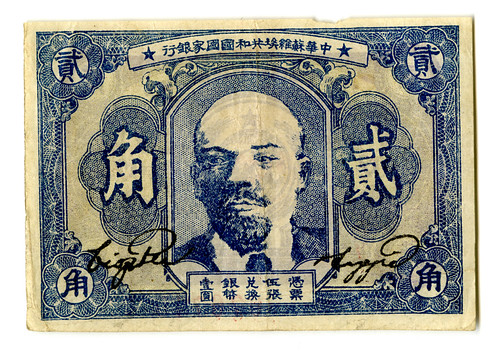
National Bank of the Soviet Republic of China, 1932
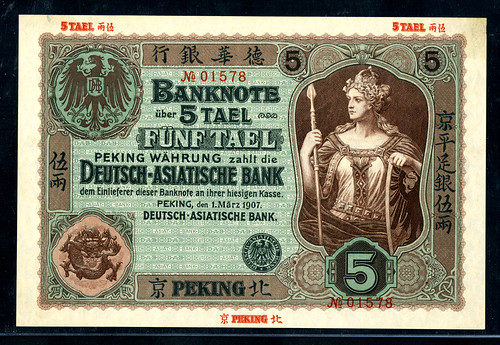
Deutsch-Asiatische Bank, 1907 Peking Branch
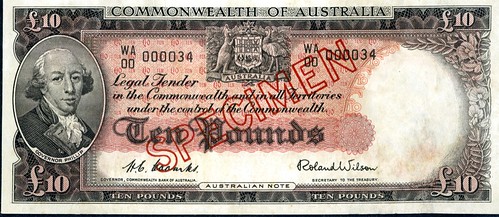
Commonwealth of Australia Specimen Banknote ca (1954-59)
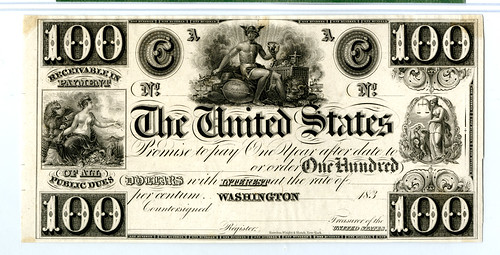
1837 Interest Bearing Proof Treasury Note
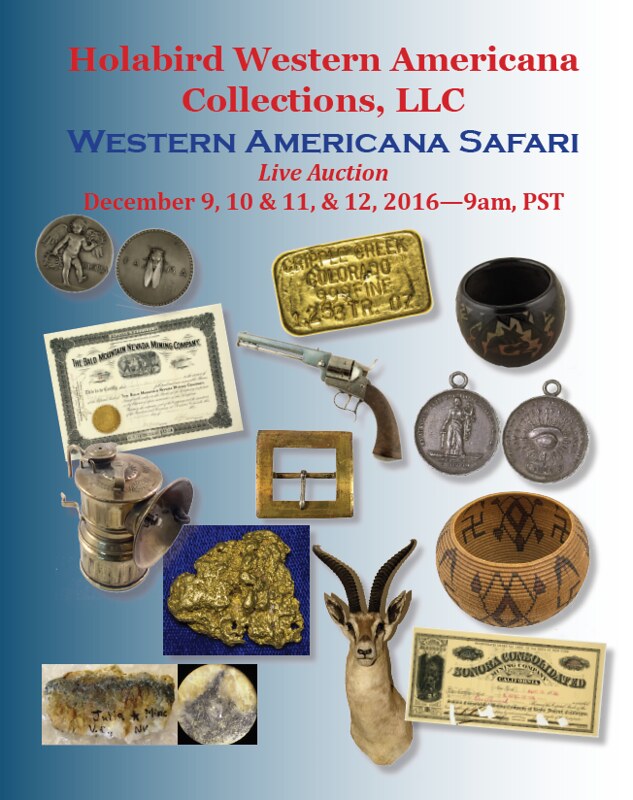
VICTORIA CROSS MEDAL FOUND IN THAMES RIVER
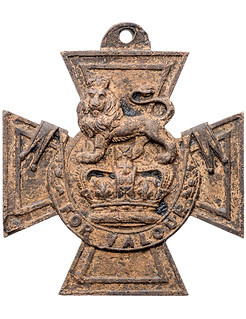 One of the earliest Victoria Crosses ever awarded has been discovered in the mud of the River Thames.
One of the earliest Victoria Crosses ever awarded has been discovered in the mud of the River Thames.
Tobias Neto, a ‘mudlark' – one of the amateur treasure hunters who search the mud of the Thames when the tide is out – discovered the rare medal in December 2015.
He reported the find to the Portable Antiquities Scheme and research began into who the medal could have belonged to.
“It was covered in mud. I kept it and carried on detecting. Only when I got home did I realise I had a VC medal in my hands - I could read the writing ‘For Valour' below the crown.
“Eventually I noticed the date on the reverse: 5 NOV 1854."
The date has allowed Tobias and researchers from the Museum of London to narrow down candidates for the medal's owner. The medal was awarded for actions in the Battle of Inkerman during the Crimean War. The battle was part of the Siege of Sevastopol, a decisive allied victory in the Crimean War.
A number of VC medals were awarded for the Battle of Inkerman, and the whereabouts of two of those medals are recorded as unknown.
Two men are thought to be the possible recipients of the medal: Private John McDermond, from the 47th (the Lancashire) Regiment and Private John Byrne from the 68th (Durham) Light Infantry.
The Victoria Cross is the United Kingdom's highest award for valour. It was instituted by Queen Victoria in 1856 to recognise “those officers or men who have served Us in the presence of the Enemy and shall then have performed some signal act of valour or devotion to their country.”
There have been 1,355 recipients of the Victoria Cross since its institution. Tradition has it that all the Crosses are struck from metal derived from Russian cannon captured at Sevastopol, although recent tests suggest the metal used is Chinese in origin, and not Russian.
But how this particular medal ended up at the bottom of the Thames is another mystery which is yet to be solved.
For more information, see:
List of Victoria Cross recipients by campaign
(https://en.wikipedia.org/wiki/List_of_Victoria_Cross_recipients_by_campaign)
List of Crimean War Victoria Cross recipients
(https://en.wikipedia.org/wiki/List_of_Crimean_War_Victoria_Cross_recipients)
To read the complete article, see:
Mystery
Victoria Cross found in River Thames mud refuses to give up its secrets
(http://home.bt.com/news/uk-news/mystery-victoria-cross-found-in-river-thames-mud-refuses-to-give-up-its-secrets-11364112711464)
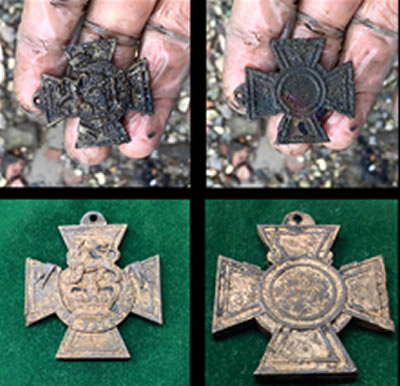
Putney resident and member of PutneySW15.com Tobias Neto has enjoyed mudlarking for the past two years and take his metal detector to the foreshore three to five times a week, depending on his schedule and, of course, the tides.
He told this website:
"It's a hobby that keeps me healthy and teaches me a whole new world of history. On the 17th December 2015, whilst detecting on my usual area (I prefer not to disclose the area ) on the Thames foreshore, I came across what looked at first like a large brooch or medal, about 3 inches deep. It was covered in mud. I kept it and carried on detecting. Only when I got home did I realise I had a VC medal in my hands ( I could read the writing "FOR VALOUR" below the crown). Eventually I noticed the date on the reverse: 5 NOV 1854."
Tobias had already made some interesting finds: "Previously I had found important historical artifacts such as a 13th century Pilgrim badge, a syringe to treat syphilis from the 18th century, Elizabeth I, Charles I, & II hammered coins, Roman coins and even a Quarter Stater Celtic coin dated 40 AD."
But the VC tops the lot. When he reported his find, he was told by the Museum of London's Finds Liaison Officer, Ms Kate Sumnall;"Do you realise you have the find of a lifetime? You might be the only person in the world to have found a VC medal. "
Tobias' research began and whilst sixteen Victoria Crosses were awarded to British soldiers on the 5th November 1854 after the Battle of Inkerman (a battle fought during the Crimean War between the allied armies of Britain, France and Ottoman Empire against the Imperial Russian Army), he discovered that there are only two names of unknown VC medals linked to the Crimean War in 1854; these were Sergeant John Byrne, originally from Castlecomer, County Kilkenny, Ireland and Private John McDermond, originally from Clackmannan, Scotland. The other fourteen are accounted for in museums and private collections.
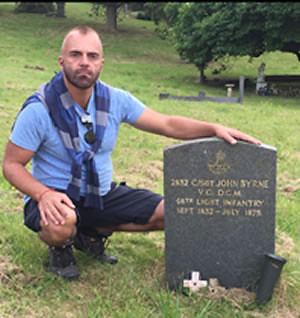 Tobias' gut feeling is that the medal belongs to Sergeant John Byrne:
Tobias' gut feeling is that the medal belongs to Sergeant John Byrne:
"I discovered Sergeant John Byrne's burial place and decided to visit his headstone at the St Woolo's Cemetery, Newport, Wales. He's been from day one my number one suspect and that was the main reason of my visit. I've always thought the medal belonged to him."
At the time of the battle John Byrne was a private and twenty two years old, he was awarded the medal for his actions when his regiment was ordered to retire, he went back towards the enemy, and, at the risk of his own life, brought in a wounded soldier, under fire.
The reason the ownership is not known is that although the date of the battle is on the reverse of the cross the name of the recipient would be engraved on the suspender bar which is missing - Tobias continued to search for this in the mud of the Thames.
Tobias said: "I'm very grateful to the MoL support with the research. Now the VC medal will be on display at the MoL from Thursday 10th November 2016 for 6 weeks, some 160 years since when it was first created by Queen Victoria in 1856."
To read the complete article, see:
Putney Mudlarkers' "Find of A Lifetime"
(www.putneysw15.com/default.asp?section=info&page=conviccross001.htm)
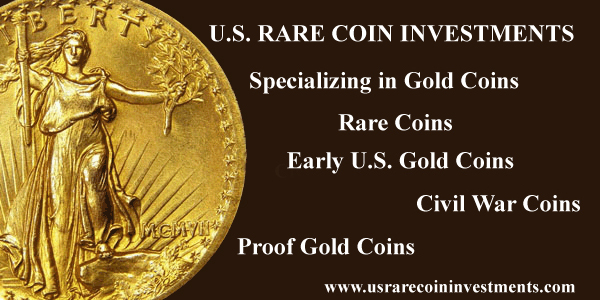
THE ALLY FINANCIAL LUCKY PENNY FOUND
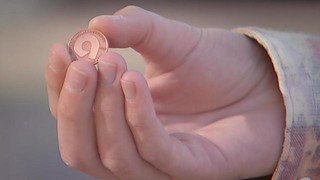 John Haley and his fiancée had been searching for Ally Bank's lucky pennies since the scavenger hunt started.
John Haley and his fiancée had been searching for Ally Bank's lucky pennies since the scavenger hunt started.
Haley was searching for a penny in Freedom Park about two weeks ago when his fiancée called to tell him that she saw a hint about the location of one of the pennies on Ally Bank's Twitter account. Haley said the picture hinted at Cabo Fish Taco, a popular restaurant in NoDa.
Haley made it to the restaurant within 20 minutes, just in time to pick up the penny.
"(I) just came across the street, kind of saw it gleaming like a Super Mario coin, so I came across, grabbed it and called her up,” Haley said. “Naturally she didn't believe me at first, so I had to send her a thousand pictures to make sure it was real."
Haley said the penny was hidden in a tiny groove of the bench outside the restaurant. He went on the company's website and entered the coin's code so he could win $1,000.
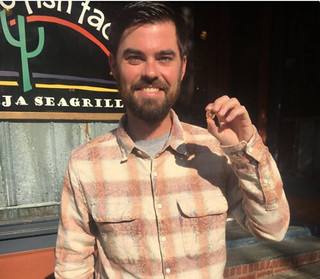 He said he already has big plans for the money. He's planning to get married in June.
He said he already has big plans for the money. He's planning to get married in June.
Haley found the fifth penny in Charlotte. Ally Bank said there are still four pennies hidden across the Queen City. The other pennies were found at Romare Bearden Park, the Charlotte Convention Center, near Discovery Place and outside Bakersfield in Dilworth.
The lucky pennies are copper-color like real pennies, but feature the Detroit-based bank's logo instead of Abraham Lincoln's head. The flip side of the coin lists its value at 100,000 cents.
To read the complete article, see:
Finder of $1,000 'lucky'
penny reveals how he found the rare coin (www.wsoctv.com/news/local/founder-of-1000-lucky-penny-reveals-how-he-found-the-rare-coin/466370016)
To read the earlier E-Sylum article, see:
THE ALLY FINANCIAL LUCKY PENNY (www.coinbooks.org/esylum_v19n43a28.html)
Good For One Free Dram
If you recently picked up a gold coin that said “H&D” and “good for one free dram,” you now know where to use it: Hearth & Dram.
Sources who are not pirates or leprechauns say the new, independent restaurant will open at 1801 Wewatta St., in the Union Station neighborhood, in January.
Hearth & Dram, lead by executive chef Jeffrey Wall, will offer a familiar Denver dining experience of rustic American fare that is “adventurous and approachable,” according to a press release. The menu will be seasonal and locally sourced when possible.
To read the complete article, see:
Here's who left coins “good for one free dram” all
around Denver (www.denverite.com/heres-left-coins-good-one-dram-around-denver-hearth-dram-23172/)
SHANNA SCHMIDT NUMISMATICS INC. LAUNCHED
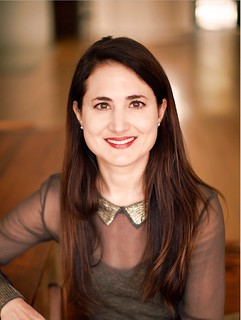 Shanna Schmidt is pleased to announce the launch of her company Shanna Schmidt Numismatics Inc. (SSNI), as well as her website, www.shannaschmidt.com.
Shanna Schmidt is pleased to announce the launch of her company Shanna Schmidt Numismatics Inc. (SSNI), as well as her website, www.shannaschmidt.com.
Shanna, the daughter of Harlan J. Berk, worked in the family business since 2005 as an expert in ancient coins, with a particular emphasis on Greek coinage. Shanna takes great pride in a few major accomplishments while working in the family business: the launch of the Harlan J. Berk Numismatic Library, a cooperation with the University of Chicago Regenstein Library. Since completion in 2016, all books in the library have been assigned Library of Congress numbers and is fully accessible to the public. Shanna is also one of the founders and former educational director of History in Your Hands Foundation, as well as the new coin bourse, Chicago Coin Expo, to take place April, 2017 at the Chicago Cultural Center in downtown Chicago.
With the establishment of SSNI, Shanna will continue to offer auction representation services as she had done at Harlan J. Berk Ltd. She routinely attends all the major auctions in the U.S. and Europe and is available for phone or online bidding for any auction. Shanna will also offer appraisal services for interested customers. Her website will feature a select group of coins that will be available for purchase.
Shanna Schmidt graduated from the University of Illinois with a Bachelor of Science in 1993. Her course of study was Communications, with a minor in Classical Piano. Afterwards, she worked for the Chicago advertising firm Leo Burnett both in the USA and abroad, in Copenhagen and Frankfurt. After almost ten years of working overseas, Shanna Schmidt returned to Chicago to work in the company her father had founded, Harlan J. Berk Ltd. Apart from these activities, she graduated with a Master's degree in Liberal Arts from the University of Chicago in 2013. Her Master's thesis was on the Cultural Property Debate as it relates specifically to ancient coins. In 2016 Shanna Schmidt decided to become an independent coin dealer, enabling her to focus efforts on her customers and building their collections.
Shanna Schmidt is a full member of the Professional Numismatists Guild since 2008 and held a board member position with the IAPN.
To visit Shanna's web site, see:
www.shannaschmidt.com
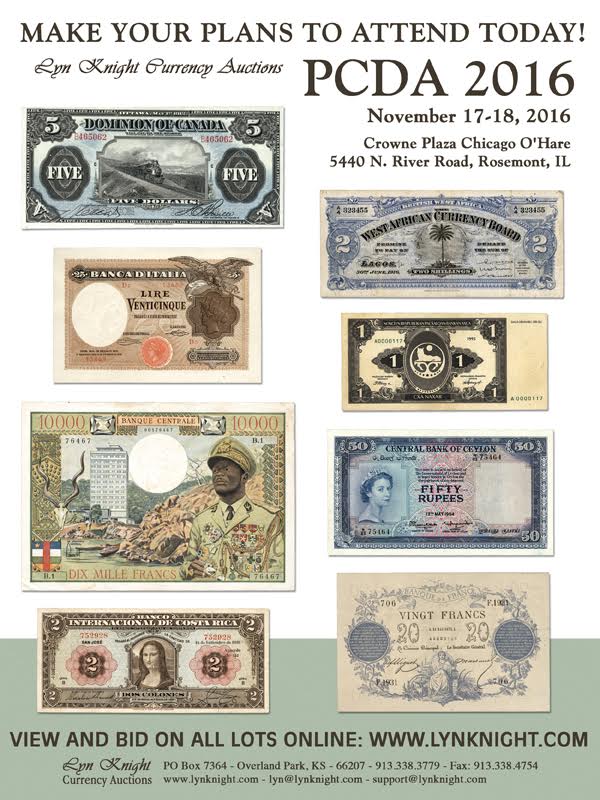
WAYNE'S NUMISMATIC DIARY: NOVEMBER 20, 2016
The evening of Tuesday November 15, 2016 I made my way to J. Gilbert's in Mclean, VA for the monthly meeting of my numismatic social group, Nummis Nova. Our reservation was for 6:45, but I arrived around 6. Waiting in the lobby was Eric Schena. I checked my phone to find a text from my guest for the evening. Len Augsburger was in town doing some work for the Newman Numismatic Portal at the Smithsonian National Numismatic Collection. He was at a table in the crowded bar, and Eric and I made our way over to him and sat down. Soon we were joined by fellow early birds Lenny Goldberg and Wayne Herndon.
I introduced Len to Lenny. He already knew Eric and Wayne. He told us about the Smithsonian work as we ordered drinks. I forget what prompted it, but I mentioned my visit to a vinyl record shop when I was in St. Louis recently. That led to a discussion of favorite music and Eric told us he'd been a radio DJ for three years in college. I told him, "Gee, you're cooler than we thought!" When he told us it was a heavy metal show, I said, "OK, you're WAY cooler than we thought."
Eric had some good stories about getting passes to concerts and phone calls from listeners in the county jail. He was glad to play their requests.
Before long our table was ready and we moved to a small room just off the main dining room. I ended up seated across from Len, next to Steve Bishop. Between me and Len were Wayne Herndon and Roger Burdette. Other attendees included Robert Hoppensteadt, Mike Packard, Julian Leidman, Joe Esposito, Dave Schenkman and Joe Levine.
Conversation naturally turned to the recent election and a discussion of the Electoral College. Generally, we like it and felt it served the purpose the founders intended. Other topics included famous people we'd met. Joe Levine knew Donald Trump's older brother Fred. Another time at a reception Jimmy Hayes said to Joe, "I want you to meet my friend Tony." The two talked for a good while, but it wasn't until later Joe realized he'd been speaking with Supreme Court Justice Anthony Kennedy.
Overstruck Russian Coppers
Sitting next to Steve Bishop gave me an opportunity to speak with him about one of his specialties, overstruck Russian copper coins. Among his
display items were two copper coins of Catherine the Great (1762-96) struck over coins of 1762. Steve responded yesterday with a detailed article we
may publish in a future E-Sylum. Here's an excerpt. Thanks, Steve!
Copper Coins of Catherine the Great (1762-96) Struck Over Coins of 1762
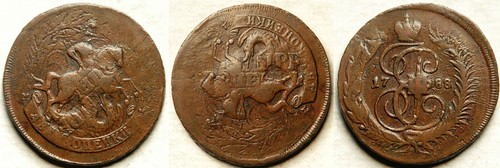
1788 MM 2 Kopeks struck over 1762 4 Kopecks
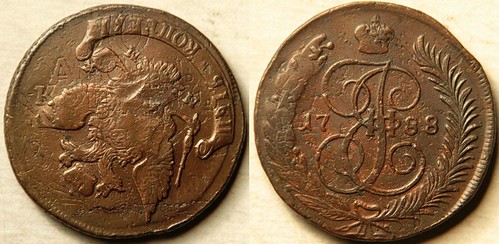
1788 MM 5 Kopecks struck over 1762 10 kopecks
Steve writes:
The two coins that instigated my conversation with Wayne are pictured above. The question that Wayne asked about these two pieces was logical. How did I know that these coins were struck over the coins that I claimed they were, since he could not see any trace of the date 1762 in the undertype?
It is a truism in overstrike collecting that the exact date of the undertype is not identifiable in many cases because the overstrike obliterates the old date. Thus, it is often the case that only the general type and a date range are identifiable. In this case, I know that the coins were struck over 1762 coins for two reasons. First, this particular date and mint combination are very commonly found struck over 1762 coins. The 1762 coins were overstruck by Catherine the Great because Peter III, who ruled briefly in 1762, had changed the monetary standard so that the value of the copper coins were doubled by halving the amount of copper. That is, the value of one ruble of copper was deemed now to be worth two rubles. One kopeck became two kopecks, two kopecks became four, etc.
Catherine changed the monetary standard back to what it had been previously. Although two kopeck and five kopeck pieces of Catherine are sometimes found struck over two and five kopecks of Elizabeth, most of them were struck over the 1762 issue to prevent coins of the same weight but different denominations from circulating concurrently. This is the primary reason that the copper coins of Peter are so scarce. Secondly, Peter's coins had a distinctive design, so by seeing the traces of his designs on an overstruck piece, no signs of the date are necessary to identify the date of the undertype, since his coins were struck only in 1762.
Pennsylvania Slate Company Note
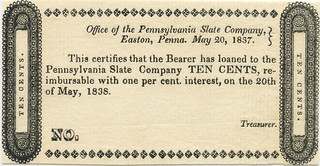
The first item I saw passed around the table was this neat interest-bearing scrip note from the Pennsylvania Slate Company in Easton, PA brought by Dave Schenkman. Dave only knows of two other slate companies that issued notes.
QUICK QUIZ: 1% interest on ten cents from 1837 til now = ?
Earliest Token Dies
Dave Schenkman blew me away with his next exhibit. Being passed around the table was an early half-dime sized Baltimore token from Robert
Soulsby's Vaux Hall (misspelled Voux Hall), accompanied by the very dies used to strike it! Amazing.
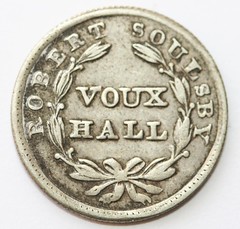
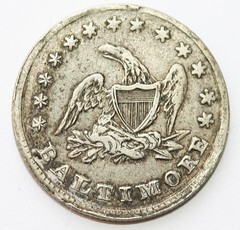
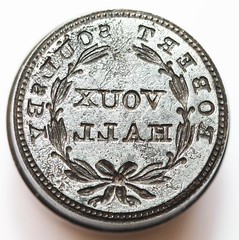
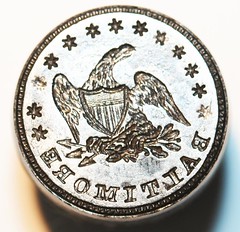
Dave writes:
Rulau lists the token as MD 159. He gives the dates of issue as 1845-6, but Soulsby was owner of the Vaux Hall Tavern (or Garden, as it was often referred to) as early as 1838. These dies surfaced in a Baltimore flea market many years ago, and I was able to purchase them. To the best of my knowledge it is the earliest known set of token dies.
Covered Bridges and Tokens in Virginia
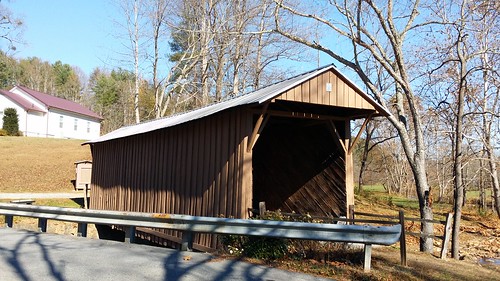
Jack's Creek bridge in 2016
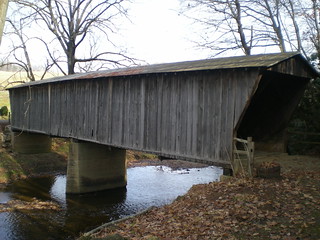
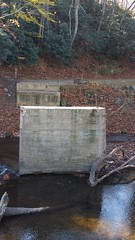
Bob White bridge in 2012; remains in 2016
Our room was cramped and our table long, so I didn't get to speak much to the folks at the other end. Eric Schena provides this report:
I had some neat discussions down my end of the table with Dave, both of the Joes, Julian, and Mike. Lots of token talk (natch :-)) but did a little discussingof the Stack's Bowers auctions at Baltimore, neat colonial coppers, the changing colors of the leaves, plus the covered bridges of Patrick County, Virginia.
The previous weekend, I went down to Martinsville to help at my wife Heather's family's homestead and on my way back, it was a clear fall day so I decided to take a somewhat more scenic route to I-81 than the usual road. I went through Bassett, Woolwine, Floyd, Riner, and ended up at Christiansburg. The scenery was excellent since the leaves were just past peak (but not too much) and that afforded me to stop and take pics of the covered bridges in Woolwine.
Until last year, there were two covered bridges in the county (and eight in the state), the Bob White Covered Bridge and Jack's Creek Covered Bridge, but that changed when a sudden flood in 2015 washed the Bob White completely away. I took pictures of the bridge a couple years prior so I have before and after shots now. I also took a bunch of pics of Jack's Creek in case that, too, disappears. In case you are curious, the nearest covered bridge to the DC area is the Meem's Bottom Covered Bridge outside of Mt. Jackson in Shenandoah County. Not only can you get to it easily off of Rt. 11 but you can drive over it (which I have done).
It is sudden events like what happened to the Bob White bridge that keep my desire to photograph these vernacular and often ephemeral structures (like general stores and rural banks) before they are all gone. That happened to a general store I photographed for Dave Schenkman's Virginia token book: a decaying store in Rileyville was eventually torn down and now is a church parking lot. As far as I know, the last published photo of that store is now in Dave's book.
Eric's bridge photos reminded me of a picture I took last Sunday afternoon. Middle son Tyler is learning to drive and he let me pick our destination. I wanted to drive to the Potomac river. He thought it was very far away, but the truth is, like many towns our area had turned its back on the river. It's hidden behind businesses and housing developments and you'd never know it was there without a map. But ten minutes later we pulled into a nearby park, got out of the car and walked toward the river, passing through part of a golf course on the way.
This stretch of the river has no bridges for many miles, and looks quite natural, like it might have looked hundreds of years ago before settlers arrived here. We walked out on a peat bog to some rocks and looked around for a while. Tyler took some pictures, too. Here's mine:

Eric continues:
I did not have much of anything to bring of note, except maybe one piece in keeping with the unintended Patrick County theme: a very rare token issued by W. H. Wimbish of Stuart, VA. It's in miserable (dug) condition, but is one of only two known specimens from that merchant. The gentleman from whom I got the piece found it in a lot that was apparently adjacent to Wimbish's original home in Stuart. He ran a general store there until his death of typhoid fever in 1914.
The condition may make a few folks wince, but that does not bother me one bit. It's a very rare token with some neat history behind it from a pretty part of the state. I've made a bit of a specialty of finding tokens from that county - I am now on the lookout for tokens from Stella and Woolwine.
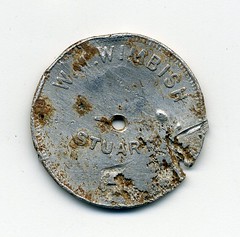
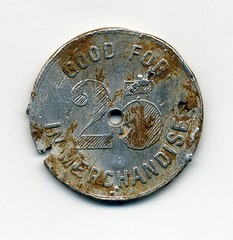
W. H. Wimbish token
Len Augsburger Visits Homren Numismatic Library
On Friday I left work a little early and headed into Washington D.C. to pick up Len Augsburger. It was his last night in town, and I'd invited
him to dinner with my family and to visit my library.
My route swung past the U.S. Capitol building, with its bright spiffy renovated dome, then past some of the Smithsonian Museums. On a crowded streetcorner I yelled over to Len, and he crossed the street and got in.
There was a lot of rush hour traffic and we crawled. But it gave us time to catch up on the week's events and plan some upcoming efforts for the Newman Numismatic Portal.
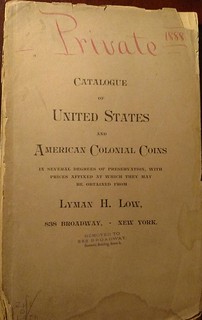 We made it a little early for our 6pm reservation at a restaurant near our home. We got a booth, and after a bit my wife and our three kids
came in to join us. It was a nice meal. Back at our house afterwards I started with a tour of our garage, which holds its share of numismatic
literature and archives.
We made it a little early for our 6pm reservation at a restaurant near our home. We got a booth, and after a bit my wife and our three kids
came in to join us. It was a nice meal. Back at our house afterwards I started with a tour of our garage, which holds its share of numismatic
literature and archives.
Once in the house we went straight into my office and library. Len was curious about the long row of binders. It's my ephemera collection. I
pulled out a copy of the key and we began pulling down binders to look through. Topics included The U.S. Mint, Proposed Coinage, U.S. Copper Coins,
Correspondence, Colonial Coins, Numismatic Americana, etc. I've accumulated a lot of rare and interesting items over the years.
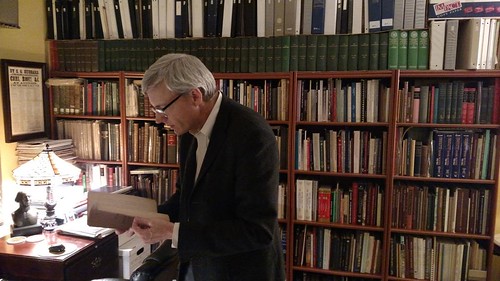
Len Augsburger in the Homren Numismatic Library
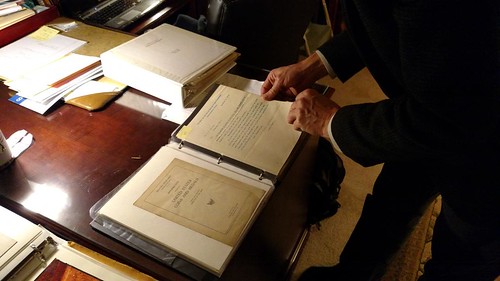
Viewing the Homren Numismatic Ephemera Files
It was a fun evening; I rarely get to share my library with visitors who really appreciate the rarity and value of this material. Len signed my guest book.
The house was really quiet when our dog Max wasn't yapping at Len. Outside I found out why - Dee and Tyler were across the street at our neighbor's house, where he and his wife had a nice bonfire going in the driveway. Len and I grabbed chairs and beverages and joined them for a while.
Later I drove Len back to his rental unit and got another great look at the monuments of Washington D.C., all lit up. Back home I put some books back on the shelves. It was another great week of numismatic fellowship.
THE BOOK BAZARRE
SILBANNACUS, THE EMPEROR THAT TIME FORGOT
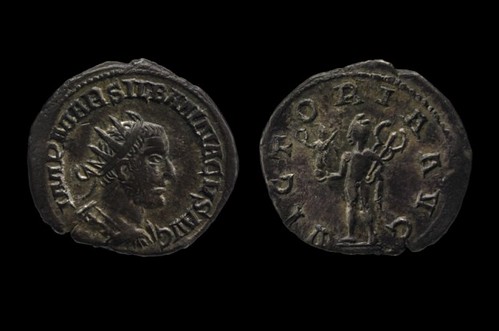
In 1937, the British Museum acquired a mysterious Roman coin from a Swiss coin dealer. Made of debased silver, and about the size of a modern British 10 pence, it bore the name and portrait of an emperor completely unknown to history.
The portrait on the mystery coin showed a young man, and the inscription around his head read IMP MAR SILBANNACVS AVG, or ‘Emperor Mar(cius?) Silbannacus Augustus'. According to the Swiss dealer, the coin had been found in Lorraine, the north-eastern region of France close to the river Rhine.
The specialists at the British Museum found no reason to doubt the authenticity of the coin, which resembled products minted at Rome during the same period. But who was Silbannacus? And when did he reign?
The emperor's name was as mysterious as his coin. No historical source, document or inscription mentions an emperor, or even a usurper, with a name resembling Silbannacus. Even the name itself is unusual – it is perhaps a misspelling of Silvannacus or Silvaniacus, which might possibly indicate northern Italian origins. Furthermore, nobody is sure what the abbreviated name MAR stands for: maybe a Roman family name such as Marius or Marcius. Yet there are no references in the historical sources to any usurper or prominent military personality of the mid-third century called Marius, Marcius, Silvannacus or Silvaniacus.
Nor did the reverse of the coin (or the ‘tails' side) provide any pointers. There were no obvious parallels among the coins of other mid-third century emperors with which to compare the design on the unique coin of Silbannacus. Instead, the design depicted a figure of the god Mercury, a deity found only infrequently on Roman imperial coins before the later third century AD.
Whatever the case, Silbannacus' coinage must have been of very short duration, and we may suppose that he reigned for no more than a few days at most. But of his life and death we know nothing whatsoever. He was an insignificant figure in a turbulent age – so much so that history has forgotten him entirely, and only two coins survive to bear witness to his very existence.
To read the complete article, see:
Silbannacus: the Roman emperor that time
forgot (www.historyextra.com/article/bbc-history-magazine/silbannacus-roman-emperor-time-forgot)
PRINCETON OPENS NEW PERMANENT COIN EXHIBIT
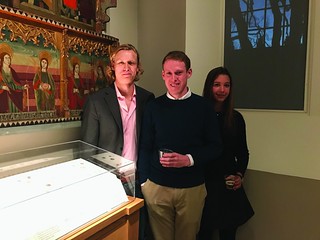 Members of the Princeton University Art Museum Student Advisory Board opened a permanent collection of ancient and medieval coins at the
museum.
Members of the Princeton University Art Museum Student Advisory Board opened a permanent collection of ancient and medieval coins at the
museum.
The collection emphasizes the importance of numismatics and reflects the University's extensive collection of coins, Dr. Alan Stahl, the University curator of numismatics, said.
The SAB consists of students dedicated to promoting student involvement at the museum. Three undergraduate students, Daniel Elkind '17, Constantin Weickart '17, and Hannah Baumann '18 led the effort to create a more extensive gallery of coins at the library.
“I got interested in coins through courses in Late Antiquity, and basically all my professors used coins in their lectures,” Weickart said. “I saw how important coins are not only as objects but also as historical sources. Princeton has one the best coin collections in the world.”
The University possesses over 110,000 coins in its collection, including coins, tokens, paper money, metals, and decorations, according to Stahl. This means the University has the largest coin collection of any university in the country.
The proposal to have more coins on permanent display was brought up in early 2015 by Elkind, Weickart, and Baumann. They brought the proposal to Stahl, and the suggestion was followed by yearlong, back-and-forth work with the art museum to bring the proposal to fruition, according to Weickart.
“We went back to Dr. Stahl and formulated the list of coins that we wanted to use. We decided on what were some of the narratives we wanted to show, what were some of the images we wanted to compare,” said Baumann. “We were in charge of writing the label and content. Even though they're so short, they are so difficult because they have to contain within it so much information.”
The Art Museum only displayed a handful of Byzantine coins in its collection, Weickart said. The new exhibit will showcase a wide-ranging collection of ancient and medieval coins from the 6th century BCE to 1400 AD.
“[The coin collection] is there primarily for educational use. A lot of classes visit the coin collection during the course of the year,” Stahl said. “Students come to do research for term papers or get images of coins to use in presentations.” Stahl added that the exhibit is also open to outside scholars for their research, especially since the coin collection will not be part of the rotating exhibit hall but part of the permanent display.
“As a classics major, I want to get people excited about the ancient world, not just the literature, but also how multifaceted and interdisciplinary the study of classics can be,” Baumann said.
To read the complete article, see:
Art Museum Student
Advisory Board opens new permanent coin collection
(www.dailyprincetonian.com/article/2016/11/art-museum-student-advisory-board-opens-new-permanent-coin-collection)

ENGLISH CIVIL WAR SILVER COIN HOARD FOUND
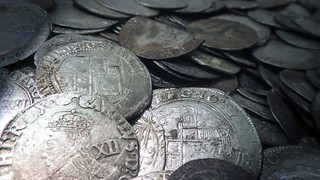 More than 1,000 silver coins buried on the "front line" during the English Civil War have been discovered in a farmer's field
in Lincolnshire.
More than 1,000 silver coins buried on the "front line" during the English Civil War have been discovered in a farmer's field
in Lincolnshire.
The hoard of 17th Century coins was found by metal detector user Steven Ingram near the village of Ewerby.
Council finds officer Adam Daubney said the discovery was "monumental".
Farmer Chris Sardeson, who owns the land, said: "I've worked this field for more than 50 years, so no-one is more surprised than me."
Fragments of the pot in which the coins were originally contained were found nearby.
Dr Daubney, finds officer for the Portable Antiquities Scheme at Lincolnshire County Council, said: "This is the largest of the hoards that has been found from that time in the county, and it contains coins from the reigns of Edward VI, Elizabeth, Mary, James I and Charles I.
"The area between Grantham and Boston was a zone of intense conflict between the Parliamentarians and the Royalists in the early years of the war, so we can think of the Ewerby hoard as being from the 'front line'.
"The hoard tells us about the uncertainty and fear that must have been felt at the time, but quite why it was buried - and by whom - is impossible to say.
To read the complete article, see:
Coins buried during English Civil War found on farm
(www.bbc.com/news/uk-england-lincolnshire-38003071)
THE BOOK BAZARRE
FRENCH JETONS FOUND IN RUSSIA
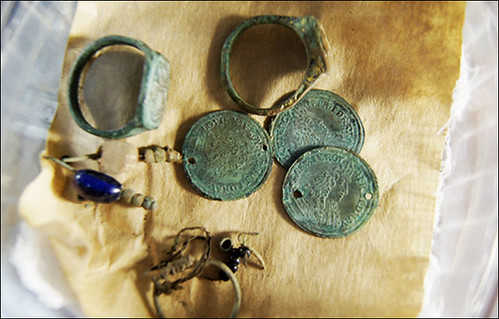
Over 300 years old, the 'jetons' - used in lieu of coins or for counting - were found along with artifacts hoarded by the Northern Selkups.
The French find and other intriguing and varied items were made during a dig in Yamalo-Nenets autonomous region, close to the Taz River. Exactly how the 'jetons' which bear Louis XIV's image came to this remote part of Siberia is not known.
Anthropologist Olga Poshehonova said a Russian-German team found 'seven similar counting tokens that depict Louis XIV'. Other discoveries - some dating to the 12th century - were 'several iron knives with handles with enamel decorations produced by Russians' and an intriguing 'lion figurine' of uncertain origin.
The treasure trove included 'brass decorations also made by Russian masters'.
One theory as to how the 'coins' reached Russia is that the tsarist government bought metal from items no longer used in European countries. Possibly they were bartered by Russians to the Northern Selkups, who were hunters and fishermen, who also herded reindeer.
Louis XIV reigned France from 1643 to 1715.
To read the complete article, see:
Stash of Sun King's
valuables found close to Arctic in Siberia
(http://siberiantimes.com/science/others/news/n0789-stash-of-sun-kings-valuables-found-close-to-arctic-in-siberia/)
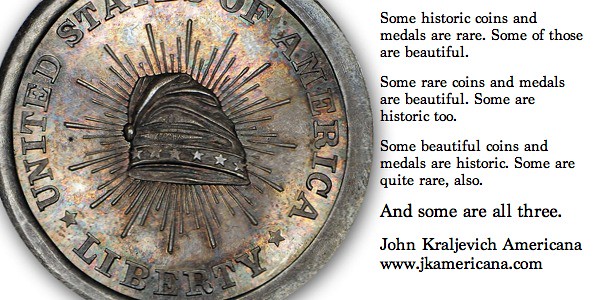
QUEEN ANNE 'VIGO' GOLD FIVE GUINEA SOLD
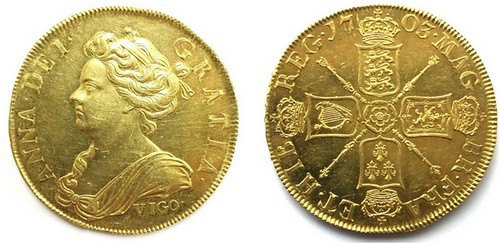
A labourer who found one of Britain's rarest coins in his four-year-old son's toy treasure chest is celebrating today after it sold for more than £270,000.
The 35-year-old had been given the 'lost' 300-year-old Queen Anne Vigo five guinea coin by his late grandfather 30 years ago to play pirate games with.
After he bought his own son a treasure chest, he dug the shiny gold coin out of a drawer and gave it to him to play with.
But he decided to show it to an auctioneer when he suspected it might not be a replica that he always assumed it to be, and produced it from his pocket in a handful of other coins. Expert Gregory Tong told the unnamed man it was one of five lost coins out of 20 that were struck with gold seized by the British from Spanish treasure ships at the Battle of Vigo in 1702.
It sold today for a hammer price of £225,000. With fees added on, the overall price paid was more than £270,000.
Mr Tong said: 'When I first told the vendor what it could be worth, he couldn't believe it. He came back to see me the next day to see if I had been pulling his leg.'
The coin was made 314 years ago and was the first British coin ever to feature the name of the battle it was won in. The series of Queen Anne 'Vigo' five guinea pieces were produced as part of an attempt to detract attention from the failure of the British to capture the Spanish port of Cadiz, highlighting instead the haul of treasure they seized on their way home.
Even in 1703, when Sir Isaac Newton oversaw their production when he was master of the Royal Mint, they would have been extremely expensive and bought only by the rich.
To read the complete article, see:
Pot of gold: Rare
300-year-old coin found in four-year-old's toy treasure chest sells for £270,000
(www.dailymail.co.uk/news/article-3942766/Gold-coin-four-year-old-s-toy-treasure-chest-sells-270-000.html)
David sent along the catalogue description for the recently-sold piece, which says it was only the 6th known example offered for sale in 50 years:
Lot 116 An Extremely Rare Queen Anne 'Vigo' Five Guinea Gold Coin:
"Vigo" beneath shoulder variant, as in The Royal Mint Sir Isaac Newton room example, with cross patee stop to the edge, with title "Decus Et Tutamen Anno Regni Secundo", weight 41.9 grams. Note: The coin is one of only twenty made from the 7.5lbs of gold seized from Spanish treasure ships by the British in Vigo Bay, northern Spain, on 23rd October, 1702.
The British fleet had failed in its attempt to take Cadiz but managed to seize gold and silver from Franco-Spanish treasure ships coming back from America. Struck the following year, the coins were made as part of an attempt to detract attention from the British failure at Cadiz, highlighting instead the haul of treasure they seized on their way home. The treasure was delivered with full pageantry through London and received at the Royal Mint by the Master of the Mint, Sir Isaac Newton.
This coin is only the sixth example to be offered for sale in the last 50 years. Estimate : £ 200000 - 250000 Event Date : 2016-11-16
To read the complete article, see:
Fascinating world of the five-guinea piece
(/www.antiquestradegazette.com/news/2005/fascinating-world-of-the-five-guinea-piece/)
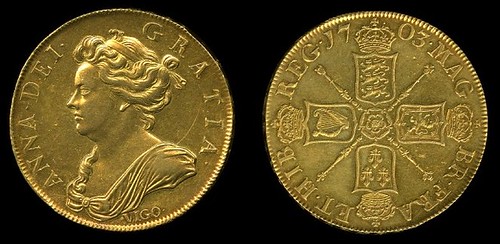
To read the complete collection record, see:
Gold coin. Gold 5 guinea coin of Queen Anne, inscribed 'VIGO', made from gold from Spanish treasure ships.
(www.britishmuseum.org/research/collection_online/collection_object_details/
collection_image_gallery.aspx?partid=1&assetid=1174940001&objectid=1060264)
David adds:
Let's just hope the Spanish don't want it back!
To read the earlier E-Sylum articles, see:
DRAWER FIND: 1703 QUEEN ANNE VIGO FIVE GUINEA PIECE
(www.coinbooks.org/esylum_v15n48a24.html)
QUEEN ANNE 'VIGO' GOLD FIVE GUINEA FOUND
(www.coinbooks.org/esylum_v19n44a26.html)

1912 TIFFANY CARPATHIA MEDAL SOLD
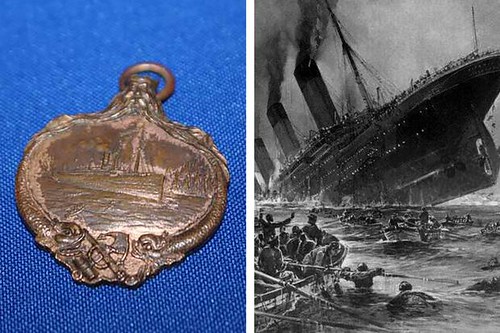
A RARE medal that was issued to the crew of the Titanic rescue boat, RMS Carpathia, has sold at auction in Glasgow for £2,200.
The 1912 medal, which was issued by world-renowned jewellers Tiffany, on behalf of the Titanic Relief Fund Committee, was awarded to John McQuair, 22, who was serving as a first class waiter on the Carpathia when it was involved in the rescue operation.
It shows an image of the Carpathia on the front with an inscription on the back that reads: “Presented to the captain, officers and crew of RMS Carpathia in recognition of fallen heroic services from the survivors of the SS Titanic, April 15, 1912.”
As the Carpathia made her way to the stricken liner, she had to brave dangerous ice fields and diverted all steam power to her engines to try to get to the ship as quickly as possible.
Although she arrived two hours after the Titanic had sunk, she was able to rescue 705 survivors from the ship's lifeboats.
Brian Clements, from McTear's in Glasgow, said: “The story behind this medal is filled with heroism and tragedy as the crew of the Carpathia fought to help the Titanic survivors.
“There are only a handful of these historic medals in existence, and they rarely come to auction, so we knew there would be considerable interest in the piece. We received a number of bids from collectors across the UK, and we believe the £2,200 paid by a bidder from Glasgow represents the highest price achieved at auction for a Carpathia medal.”
To read the complete article, see:
Titanic medal fetches £2,000 at Glasgow
auction (www.eveningtimes.co.uk/news/14906061.Titanic_medal_
fetches___2_000_at_Glasgow_auction/)
1933 FOOTBALL ASSOCIATION CUP MEDAL
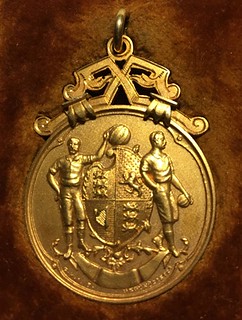 Medals won by former Everton winger Cliff Britton (1909-75), who later went on to manage the club in the 1950's, are being offered at an
auction in East Yorkshire.
Medals won by former Everton winger Cliff Britton (1909-75), who later went on to manage the club in the 1950's, are being offered at an
auction in East Yorkshire.
Britton was a wing-half known for his pinpoint crossing. Although he scored only three times in his 242 appearances for Everton between 1930 and ‘38, he provided plenty of assists for the club's record goalscorer, Dixie Dean.
The medals have been consigned by the former player's family to Hawleys and will offered at its sale at Beverley Racecourse on November 20.
John Hawley, who runs the auction firm, had an interesting personal connection to Britton. In his youth, Hawley was a trainee at Hull City and Britton was his first manager.
The 10-lot consignment from the Cliff Britton collection includes his FA Cup winner's medal from 1933. Everton beat Manchester City 3-0 in the final that year, with Britton heavily involved in two of the goals.
As well as the FA Cup medal, the auction will offer two Charity Shield medals awarded to Britton from 1931, when Everton beat Newcastle, and 1933, where they lost to Arsenal. They will be sold as a single lot with a £1000-2000 estimate.
Another lot relates to Britton's international career. From 1934-37 he won nine England caps including for a game against Scotland in 1936. A 9ct gold medal from the match is estimated at £300-500.
Also at the auction is the medal awarded to Britton as manager of Hull when his team won the 1965/66 Third Division championship. It was six years before auctioneer Hawley would later make his debut for The Tigers.
To read the complete article, see:
FA Cup winner's medal
from Everton's Cliff Britton appears at auction
(www.antiquestradegazette.com/news/2016/fa-cup-winner-s-medal-from-everton-s-cliff-britton-appears-at-auction/)
For more information on the FA Cup, see: https://en.wikipedia.org/wiki/FA_Cup

SHERLOCK HOLMES CARD DEALER 'COIN'
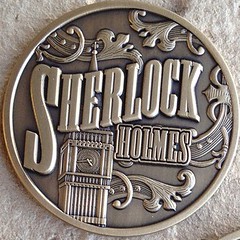
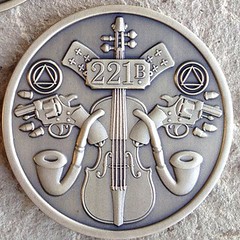
In August, we reported on a dealer coin that was struck to accompany a Hounds of the Baskervilles card deck noted playing card designer Jackson Robinson.
Robinson also came out with a card deck honoring Sherlock Holmes, in several different variations. These cards sold out fairly quickly, but still can be found for sale on several of the online auction services.
In addition to the card deck, a dealer coin was also struck with the emblems from the card deck. In a casual game of poker, the right to deal a hand typically rotates among the players and is marked by a coin called a dealer button (or buck). In a casino, a house dealer handles the cards for each hand, but the button (typically a white plastic disk) is rotated clockwise among the players to indicate a nominal dealer to determine the order of betting. These dealer coins also sold out quickly, but can be found for sale on several of the online auction services.
OBVERSE: SHERLOCK / HOLMES / (Big Ben tower with a filigree wreath in the background)
REVERSE: 221B / (central design of a violin, with mirror images on both sides of the Vermissa Lodge seal/brand, a revolver with 3 bullets, and a calabash pipe)
Round, 50.8mm, antique bronze enamel
To read the complete article, see:
Dealer Coin for the Sherlock Holmes
Playing Card Deck by Kings Wild (http://fourthgarrideb.com/2016/11/dealer-coin-for-the-sherlock-holmes-playing-card-deck-by-kings-wild/)
U.S. PRESIDENT CHANGE DRIVES NUMISMATICS
Donald Trump's election Nov. 8 as the 45th president of the United States opens the door to a number of numismatic collectibles for hobbyists to pursue and will result in changes at the Treasury Department and possibly the U.S. Mint.
Prime among the new collectible items are the official presidential inaugural medal to be issued through President-elect Trump's inaugural committee, as well as U.S. paper money, which will eventually bear the signatures of a new Treasury secretary and U.S. treasurer.
Inaugural medal
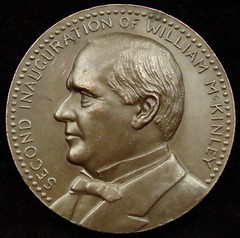 The official inaugural medal is issued by the winner's inaugural committee and should not be confused with the traditional Presidential
medal struck and issued by the U.S. Mint using designs from one of the members of the Mint's engraving staff.
The official inaugural medal is issued by the winner's inaugural committee and should not be confused with the traditional Presidential
medal struck and issued by the U.S. Mint using designs from one of the members of the Mint's engraving staff.
Issuance of an official inaugural medal for each presidential inauguration has been a tradition since the first one was issued in 1901 for the inauguration of President William McKinley.
First term medals feature a portrait of the president on the obverse; second term medals traditionally show the vice president's portrait alongside the president's.
Changes in Signatures
 With Trump's election as president, Treasury Secretary Jacob Lew will be out of the cabinet. And his signature will be eventually replaced
on U.S. paper money with that of his successor.
With Trump's election as president, Treasury Secretary Jacob Lew will be out of the cabinet. And his signature will be eventually replaced
on U.S. paper money with that of his successor.
President-elect Trump has previously indicated that he wants to give the Treasury secretary job to his finance chairman, Steven Mnuchin, a 17-year-veteran of Goldman Sachs.
Mnuchin is the chairman and chief executive of the private investment firm Dune Capital Management. Mnuchin was also co-founder, chairman and CEO of OneWest Bank, which was sold to CIT Group in 2015.
Another office awaiting a Trump appointment is that of United States treasurer. The treasurer's facsimile signature appears on Federal Reserve notes with that of the Treasury secretary.
The new administration may also lead to the appointment of a Director of the U.S. Mint. Stay tuned!
I've added images to the excerpt. The McKinley medal is from the great Medals and Tokens web site by dealer Bill Carm, and the Lew signature is from a New York Times article. See the links below. -Editor
To read the complete article, see:
1901 Official
Inaugural Medal President William McKinley 44 mm Bronze
(www.medalsandtokens.com/us-medals-and-tokens-1/1901-official-inaugural-medal-president-william-mckinley-44-mm-bronze)
To read the complete article, see:
Jacob Lew's Signature, Squiggle-Free
(http://economix.blogs.nytimes.com/2013/06/18/jacob-lews-signature-squiggle-free/?_r=0)
To read the complete article, see:
Election of President-elect Trump brings
multiple collecting possibilities (www.coinworld.com/news/us-coins/2016/11/new-president-means-hobby-opportunities.html)
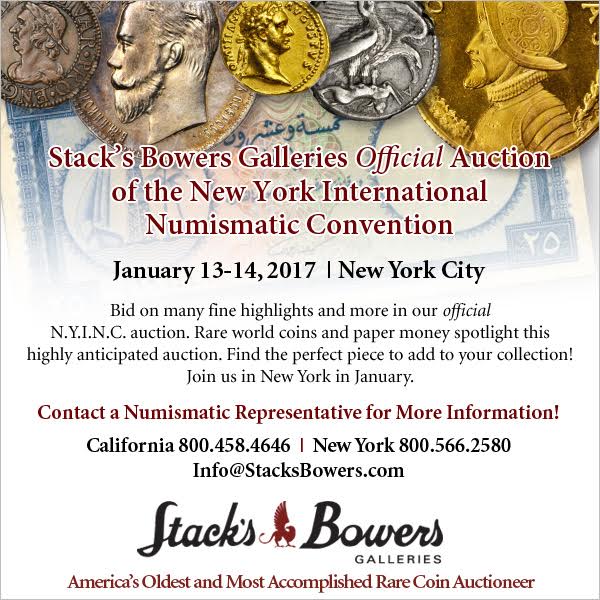
A COAST GUARD CUTTER EXCHANGE NOTE
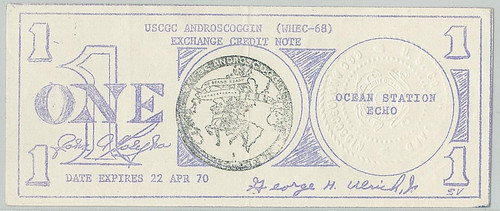
This note was issued aboard the US Coast Guard Cutter Androscoggin (WHEC-68) in April 1970 for use while the Androscoggin was located at Ocean Station Echo. Why the note was made is unclear. It was apparently used in the ship's exchange while at sea at that location. The attached picture is of SK1 Charles Quam and RM2 David Reiland at the ship's exchange during her Vietnam tour in 1969.
The note is mimeographed with the embossed seal of the Androscoggin in the window on the right side of the note. The ship's crest appears in the center. There are two signatures. The left signature is John A. Tolejko, quartermaster. The right signature is George H. Ulrich, Jr, the personnel officer. The back is blank.
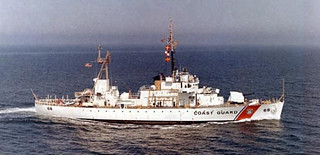 The Ocean Stations were a multi-national chain of ships at set locations that reported surface and upper air meteorological observations
for use in weather forecasting. They were primarily located in the North Atlantic and North Pacific. In addition to their weather reporting function,
these vessels aided in search and rescue operations, supported transatlantic flights, acted as research platforms for oceanographers and monitored
marine pollution.
The Ocean Stations were a multi-national chain of ships at set locations that reported surface and upper air meteorological observations
for use in weather forecasting. They were primarily located in the North Atlantic and North Pacific. In addition to their weather reporting function,
these vessels aided in search and rescue operations, supported transatlantic flights, acted as research platforms for oceanographers and monitored
marine pollution.
Ocean Station Echo was located in the mid-Atlantic. US vessels typically served 3-4 week tours at one location. The Androscoggin was on station for this tour 3-26 April 1970.
For more information about the MPC Gram, see:
MPCGram@yahoo.com

PUBLIC PROPOSES NEW BANKNOTE DESIGNS FOR EGYPT
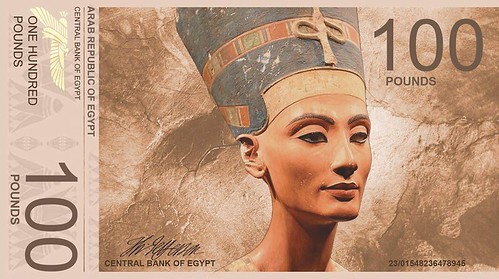
After the shocking news of the Egyptian pound floatation, a group of youth were able to think outside the box and launched a creative Facebook campaign calling on Egyptian artists to redesign the banknote of the national currency starting from 25 piasteres to LE 200.
The campaign's Facebook page created a hashtag #Egyptian_currency_design_challenge which went viral on social media with photos of several breathtaking currency designs illustrating the campaigns initiatives that would challenge Egyptian artists to get creative. “This design challenge is an open call to all Egyptian graphic artists & Illustrators to express their thoughts & share their vision by redesigning the Egyptian currency paper money,” the page said.
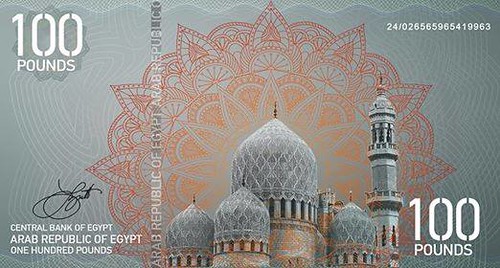
The founders of the page stressed that the challenge is not supported or accredited by any official governmental entity or institution and it is held only for the purpose of displaying our rich Egyptian art and culture by sharing visions, concepts and thoughts from talented Egyptian creative artists with the rest of the world.
The designers created intriguing designs for the 100, 200 and one Egyptian pound banknotes. Within their creative designs, the artists used photos of various iconic figures and symbols from the Pharonic era including Queen Nefertiti who has the lionshare among the designs including other such as, King Tutankhamun, Sphinx, Horus eye and Karnak temple and the Giza pyramids.
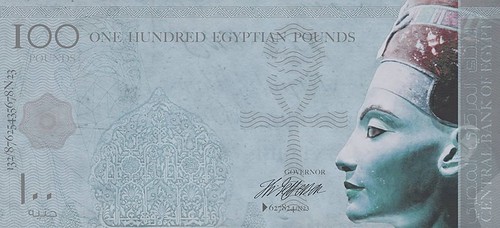
Web site visitor Timothy E. Kaldas commented:
Given that the official language of Egypt is Arabic it would be great if the designers could use that language in their design. Good design isn't just pretty, is practical.
Ahmed Hafez commented:
Can we have new bills in Arabic?? since that's the language people understand and speak? lol
To read the complete article, see:
What about new design of the Egyptian currency?
(www.egyptindependent.com/news/what-about-new-design-egyptian-currency-0)
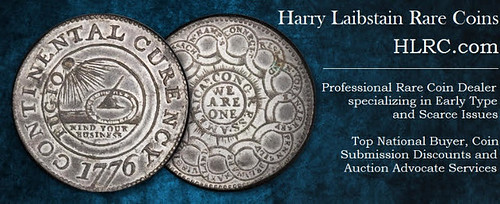
MASSIVE COUNTERFEIT CURRENCY BUST IN PERU
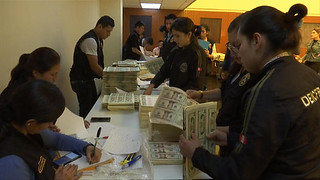 President Obama is on his way to Peru for a meeting of Asia-Pacific leaders. But not all of the Secret Service agents there are for his
protection.
President Obama is on his way to Peru for a meeting of Asia-Pacific leaders. But not all of the Secret Service agents there are for his
protection.
Overnight Tuesday, agents staged the largest raid of counterfeit currency in the agency's history.
They seized an estimated $30 million in fake cash piled in houses and apartment buildings in Lima. The bills were hauled away in trucks to warehouses, where they are being inspected and cataloged.
A large stack of the fake money came from just one house; A total of 54 were raided in all.
Police are still counting the cash and logging the evidence. Once suspects have been convicted, it will all be burned.
“Operation Sunset” was two years in the making. The Secret Service worked with 1,500 Peruvian national police officers in the raids.
Six counterfeit rings were targeted and more than 40 people have been arrested.
In addition to the counterfeit cash, agents seized printing presses, Euro notes and Japanese yen.
The lead U.S. agent on “Operation Sunset,” who CBS is only identifying as Jose, said they have “made a huge impact.”
He said Peruvian counterfeiters are among the best in the world.
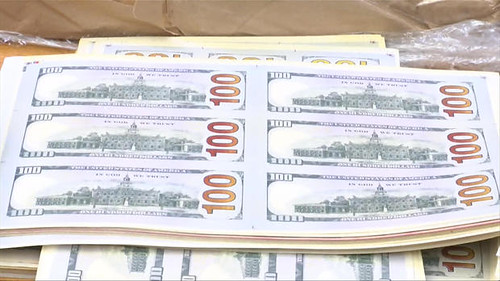
To read the complete article, see:
Secret Service makes massive counterfeit bust in
Peru (www.cbsnews.com/news/secret-service-makes-massive-counterfeit-bust-in-peru/)

INDIA'S BANKNOTE WOES CONTINUE TO MOUNT
Aruna Desai has a problem with the thousands of Indian rupees she has with her in the U.S. -- she can't find a bank to exchange her funds and couldn't give the money away if she tried.
Since Indian Prime Minister Narendra Modi removed 500- and 1,000-rupee notes from circulation, currency exchange providers in the U.S. have been unable to take the outlawed bills. Some of the country's biggest banks, including JPMorgan Chase & Co. and Citigroup Inc., work with vendors to provide rupees to clients and those vendors have made the bills unavailable, spokesmen for the banks said. Wells Fargo & Co. also said it can't supply rupees at this time, while Bank of America Corp. said it has never accepted the currency for exchange.
“If you have a euro, you can go to a bank and exchange it,” Desai, 76, of Cliffside Park, New Jersey, said in a telephone interview. “For an Indian rupee, I don't think there's any bank that does that here.”
Travelex Ltd., which operates more than 200 currency exchange stores in the U.S., said it's unable to accept the 500- and 1000-rupee bills from customers because it can't repatriate the cash in bulk under India's current rules, said Lucie Smith, a spokeswoman for the London-based company. Western Union Co., the world's largest money-transfer service, said for those locations facing a shortage of rupees, customers are able to receive checks or remittances to their bank accounts. “A lot of people are trying to give money to their friends to spend it, or else it will go to waste,” said Desai, who makes a yearly trip to India to work at a medical camp. If she can't find a place to exchange or use the bills, she'll “just have to throw it away.”
To read the complete article, see:
U.S. Banks Close Rupee
Exchanges After Large Bills Ruled Illegal
(www.bloomberg.com/news/articles/2016-11-18/u-s-banks-close-rupee-exchanges-after-large-bills-ruled-illegal)
 To ease the banknote chaos that has gripped the nation and reduce the huge queues at banks and ATMs, the Indian government on Friday told
gas stations to start dispensing cash.
To ease the banknote chaos that has gripped the nation and reduce the huge queues at banks and ATMs, the Indian government on Friday told
gas stations to start dispensing cash.
About 2,500 state-run gas stations across the country that have State Bank of India card swipe machines will permit people to withdraw up to 2,000 rupees a day using their debit cards.
The move was prompted as anger and frustration continue to grow since Prime Minister Narendra Modi announced on November 8 that all 500 rupee and 1,000 rupee banknotes were invalid, which wiped out 86% of the cash that was in circulation in the country.
To read the complete article, see:
Indian gas stations dispense cash to ease banknote
crisis (www.atimes.com/article/indian-gas-stations-dispense-cash-ease-banknote-crisis/)
To read the earlier E-Sylum articles, see:
INDIA SCRAPS 500 AND 1,000 RUPEE BANKNOTES
(www.coinbooks.org/esylum_v19n46a38.html)
RUPEE BANKNOTE BAN CAUSES PANIC (www.coinbooks.org/esylum_v19n46a39.html)
NEW INDIAN BANKNOTES PRINTED IN SECRET (www.coinbooks.org/esylum_v19n46a40.html)
INDIA BANKS RECIRCULATE SOILED BANKNOTES
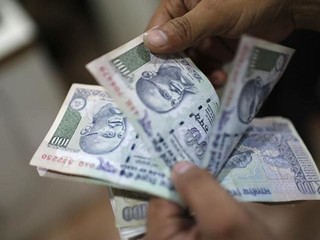 Fuelled by an unprecedented cash crunch after the government spiked high-value currency notes, some banks are receiving soiled, smelly Rs
100 notes for recirculation.
Fuelled by an unprecedented cash crunch after the government spiked high-value currency notes, some banks are receiving soiled, smelly Rs
100 notes for recirculation.
Many customers in Delhi complained to IANS that they received mouldy notes, some of which smelt ‘very bad'.
A bank manager, who asked not to be named, told IANS, “The RBI is sending old 100 rupee notes stored for years but not destroyed, These notes smell. We are spraying them with perfumes and insecticides before disbursing them.”
The manager said Rs 100 notes worth millions of rupees have been recirculated to narrow down the huge demand-supply gap in cash after the November 8 demonetisation of 500 and 1,000 rupee notes -- which accounted for 86% of the currency in circulation by value.
Usually, such soiled notes are returned to banks by the customers and they finally end up in RBI offices where they are shredded and ferried to dumping sites.
To read the complete article, see:
Banks
recirculate soiled banknotes by spraying perfumes, insecticide
(www.hindustantimes.com/india-news/banks-recirculate-soiled-banknotes-by-spraying-perfumes-insecticide/story-tlDj7jQJYgxhsYsfIOUQdN.html)
THE BOOK BAZARRE
FEATURED WEB SITE: NUMISMATICS INTERNATIONAL
This week's Featured Web Site is Numismatics International.Numismatics International (NI) was established in April 1964 and has members located worldwide. NI is the largest and most active numismatic organization in the world which excludes the sale, trade, discussion or display of coins and currency of the United States of America. This allows a focus to study and collect other countries and regions of the world.

http://numis.org/

